Dark Sun: Wind Riders of the Jagged Cliffs by oriongates
Ancient Hobbit Overlords
Original SA post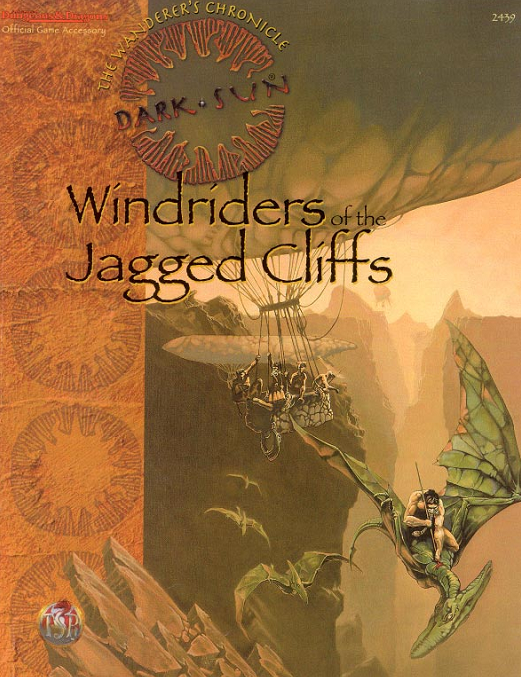
Dark Sun: Wind Riders of the Jagged Cliffs
Part 1: Ancient Hobbit Overlords
You may know Dark Sun as possible the most badass and
 Dungeons and Dragons setting ever. You may even know that it's awesomeness got a little derailed by some questionable metaplot and you might pick up a new book only to find out that some novel had killed off half of the sorcerer-kings!
Dungeons and Dragons setting ever. You may even know that it's awesomeness got a little derailed by some questionable metaplot and you might pick up a new book only to find out that some novel had killed off half of the sorcerer-kings!
Well, do you know just how freaking weird Dark Sun got before the end of second edition? Very. The answer is very. Wind Riders of the Jagged Cliffs is perhaps the best representation of the weird direction the setting took before the end.
Introduction
------------------------
The Jagged Cliffs are part of the "expanded" Dark Sun setting where we move beyond the Tablelands, the area where the Sorcerer Kings founded their cities and the heart of most human and demihuman civilization. In the Tablelands halflings are uncommon, known only as savage jungle-dwelling cannibals (I told you Dark Sun was badass) who inhabit the small rainforest nestled in the mountain range that marks the Western border of the Tablelands.
Well, apparently not all halflings are awesome, murderous mini-tarzans. Far, far to the west beyond the Tablelands is the Jagged Cliffs, home of the last "civilized" halflings in Athas. The Jagged Cliffs are a nearly sheer mountain range, as tall as two miles in places and stretching hundreds of miles in either direction. At the base of the cliffs is a fog shrouded, mutant-filled swamp.
If you're wondering what I mean by the "last civilized halflings", then get ready for some of Dark Sun's wackier bits of history.
Way back in prehistory was Atha's Blue Age, when the planet was covered in water. Yes, Athas used to be Waterworld. There were only a few island chains and two races. The primitive insect-men who would one day evolve into the Thri Kreen and the halflings. Psionics didn't exist and arcane magic wasn't even a theory yet. Back then the halflings developed a bizarre and mostly unexplained technology of "life shaping" to create living technology that they used to develop vast civilizations over much of the earth.
The halflings of the Jagged Cliffs (who call themselves the rhul-thaun) are the last remnant of that age and they still retain some of the bizarre halfling bio-tech secrets of old.
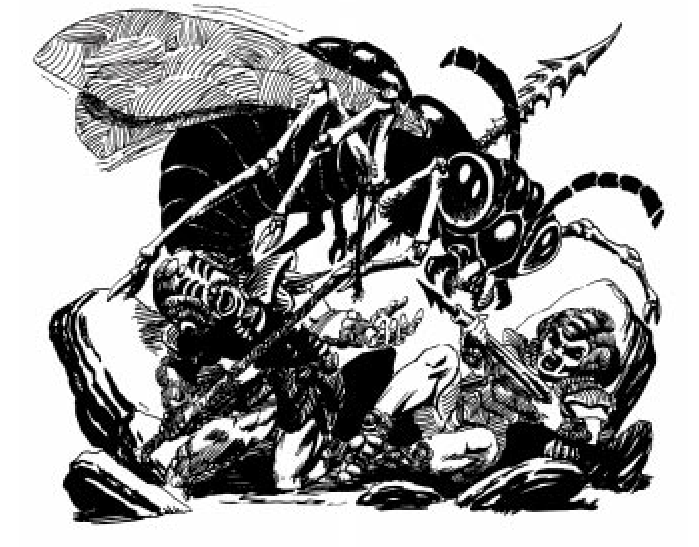
The Rhul-thaun
Stat-wise, Rhul-Thaun halflings aren't really that much different from ordinary athasian halflings (although their ability score mods aren't as extreme, +1 Dex and Wis, -1 Strength). They start with amazing climbing abilities (80% on rocky surfaces and don't suffer the -15% racial penalty to wall climbing normal halflings thieves do). Otherwise they're pretty much identical. They live longer than most any other race, around 150 years, largely because they just have a better standard of living. Their relatively high levels of medical and biological knowledge means that more of them survive childbirth as well. It's a surprise they aren't scurrying all over the place!
One notable difference in living along the Jagged Cliffs is called Rajaat's Curse (those who know Dark Sun's weird metaplot know Rajaat as the "father" of arcane magic in general and defiling in particular. His involvement will be explained later). This is a general term used for deformities or any other disease without a known cause. Living above the swamps has given the rhul-thaun halflings an unfortunate tendency to develop mutations which range from minor changes in skin color or relatively normal birth defects all the way up to fully functional extra limbs, gills, tough skin, and bonuses to stats. Being a mutant would be kind of rad if it weren't for the fact that it gets you shunned.
Of course, it's all the Rhul-Thaun's own fault. Living above a massive magical toxic waste dump isn't good for you in the first place, and millenia ago the halfling's ancestors intentionally made their DNA more "flexible" in order to allow for easier life-shaping, so the rhul-thaun are extra susceptible to mutation (1% have minor mutations, and .1% have major ones). But, as you'll see, the Rhul-Thaun are pretty much in the habit of screwing themselves over.
One of the biggest cultural elements of Rhul-thaun life is ritual. Everything is ritualized and performed in very specific, often very intricate patterns. They have formal ceremonies for greetings, eating, dressing, selling, buying, fighting, dancing and just about everything else. Despite this there is no real religion to speak of among the cliff-halflings. Of course, there are no gods in Dark Sun to begin with, but unlike most other cultures they don't have cults or false dieties (like the sorcerer-kings). They have a generalized reverence for the power and strength of nature and life, but they don't usually worship the elements directly...they're seen as important but not usually worthy of veneration. Those Rhul-thaun who do decide to become elemental clerics are tolerated, except those who choose the element of fire which is seen purely as a source of death and destruction and is completely outlawed.
There is a minor "cult of personality" around the promise made by the High Lord Rhan Thes-onel, who left the Cliffs, promising to return some day to give his people a new purpose. Of course, most accept that he's long dead by now but some insist he might return in the form of a spirit or some other mystical sign.
The Rhul-thaun (like all halflings back in 2nd edition) cannot practice arcane magic and are in fact completely ignorant of it. However, exposure to arcane magic (even the relatively mild preserver magic) would be horrifying to a Rhul-thaun and an absolute abomination. They develop psionics and wild talents like everyone else on Athas but they generally see it as an unsavory ability (somewhat akin to deformity and mutation) and most will avoid using any psionic abilities they possess, thus there are no known rhul-thaun psionicists, although they have the same potential to learn it as any other race.
There's a quick section on creating a Rhul-thaun character, mostly pointing out what classes are or are not suitable for a cliff-dweller. However, there are some new Non-Weapon Proficiencies:
* Cliff Fighting: Cliff Fighting is a skill exclusive to the rhul-thaun due to their vertically oriented lifestyle. It removes any penalties for fighting while climbing and gives you a +1 to hit and +2 to damage against any opponents who are also climbing, on a ledge, etc.
* Life Shaping: The halfling bio-engineering skill. Exclusive to members of the Life Shapers guild and grants the knowledge to create life-shaped creatures and repair them.
* Ritual Knowledge: Knowing the right way to spin your fork when eating or which foot to balance on when apologizing to a merchant for soiling yourself in his store. Pretty much essential for living a normal life in rhul-thaun society.
* Tending: Apparently not included in Life-Shaping, this is the skill of actually caring for life-shaped objects, things like what to feed them, how they should be stored, etc.
* Windancing: Basically a combination of dancing and parkour. Not much detail is provided beyond this other than to say its quite pretty.
* Windriding: The thing the book is named. This is riding but with flying mounts, namely (but not necessarily) life-shaped mounts and is specific to the hazards and environments of the jagged cliffs.
Finally, if you're creating a rhul-thaun you have to roll 1d8+1d12 to determine your social status...I'm no probability wiz, does that actually produce a distribution any different from 2d10? Just curious.
Anyway, status ranges from Very Low (hobo), Low (poor), Average (working class), High (well off) and very high (totally rich). The table is weighted heavily towards Average and High status characters, so its good to see that the rhul-thaun have a thriving middle class.
--------------------------------------
Finally, we have Kits (2nd edition's class variations which range from minimal to drastic). All are warrior or rogue kits and oddly none focus on life-shaping.
Chahn Terrorist (warrior kit)
Apparently the rhul-thaun have terrorists. Honestly, from the sound of it these are the guys with the most common sense in the halfling community. They want to ditch the pointless rituals and stop living exclusively on a 2 mile-tall drop into a toxic swamp. Maybe get out there and see what the rest of the world has been up to (okay, that part's a bad idea given the general state of Athas, but you can't blame them for being curious).
Despite stating multiple times that not all Chahn terrorists are interested in violence and are often just guilty by association with more radical members, apparently all Chahn must have proficiency in the dagger and the garrote. I'm beginning to think that the chahn doth protest too much...
The Chahn get a +1 bonus to pretty much any roll they think will help overthrow the status quo, plus the benefits of being a member of an underground group of like-minded individuals.
Climber (Rogue/Warrior kit)
Only for multiclassed halfling rogue/warriors, this kit is for...people good at climbing. Climbers are also kind of the rhul-thaun equivalent of truckers or bikers: they like to hang out with one another, there are "climber only" bars, etc.
climbers can "run" while climbing and know special packing techniques which increase their encumbrance by 50%. But they spend so much time on the cliffs that they can't really handle horizontal distances too well, reducing the range of all missile weapons by 25% (which kind of sucks if you're going to be fighting flying enemies while stuck to a cliff).
Windancer (Rogue)
Just a side note, do you ever notice weird compound words, Windancer, in this case where the the first letter of the second word is deleted if it matches the last letter of the first? The sort of thing that you don't notice for the longest time but then you can't unsee it and it starts to bug you? Well, if you do then I just ruined the word Windancer for you.
As mentioned before Windancing is basically halfling parkour crossbred with dancing. They're largely performance artists in halfling cities but some of them are willing to use those skills for other purposes.
Oddly enough although windancing is listed as a Non-weapon Proficiency, it does not appear on the Windancer's list of bonus, required or even recommended proficiencies.
They can climb walls and "dance over bridges" (why only bridges?) at triple normal speed for 2 minutes per point of constitution. They also, for some reason, get a +10% to move silently and +5% to hide in shadows...but no bonus to climb walls.
Downside is their encumbrance is cut by 50% and they lose all of their bonuses outside of urban environments (so no super-fast climbing on cliffs or parkouring through a forest).
Windrider (rogue)
Not sure why this one is rogue exclusive, really seems like more of a warrior thing.
The windriders are essential to rhul-thaun civilization, serving as a combination of hunter/gatherers, scouts and postal workers. They've got kind of a "flying ace" vibe and tend to be seen as daring and flamboyant.
They get no penalty for acting while on an airborne mount and they're considered holy by the relatively small number of Air clerics in halfling society so they can pretty much always find food, shelter and help at an air temple. However, for some reason they are absolutely forbidden from developing proficiencies in riding land animals. Since they're usually sponsored by wealthy patrons they get a good chunk of starting cash.
-------------------------------------------
For some reason at the end of this chapter there's a brief section on the penalties for operating within The Misty Border (something that hasn't actually been explained yet). This boils down to A) its hard to see in lots of fog, and B) those from arid climates (i.e. everywhere else) may develop respiratory problems. Because nothing says awesome sword and sorcery adventure like pneumonia
There's also some notes on climbing. It points out that most rhul-thaun are already excellent natural climbers (80%) on rocky cliffs and most have the Mountaineering skill granting an additional 10%. On top of that there are vertical "roads" along the cliffs where exceptionally good climbing paths have been clearly marked, granting an additional +40%. But 90% of the time the mists are heavy and this makes things slick (-25% to climb chance). There's a table for "what if you fail a climbing roll" which mostly consists of a bit of a fright and maybe falling 10 feet before grabbing a new hold and taking 1d6 damage. The really unlucky could fall farther (up to 1d100x100 feet for a roll of 98-100).
Finally, we get a bit of commentary on how weird the halfling cities look to outsiders, tiny scale, organic styles of architecture and a tendency to think vertically rather than horizontally.
The next entry will be on Athas' psychedelic history.
A Brief History of Athas
Original SA post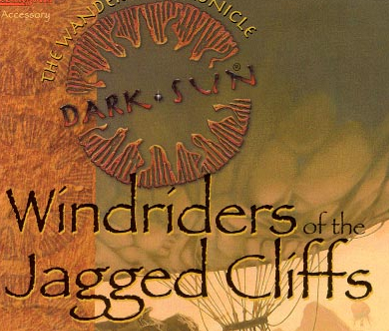
Wind Riders Of The Jagged Cliffs
Part 2: A Brief History of Athas
This was touched on in the last Fatal and Friends entry for Dark Sun but for those who don't know (and just to torment those who do know all over again), the Revised edition of Dark Sun came with a whole new and much longer history of the planet.
Originally Athas was basically just the post-apocalyptic version of a more normal fantasy world. One with less magic and metal, but still pretty normal. Then wizards in general, and the Sorcerer Kings in particular, got so pissy with each other that the drained the life from the entire planet in wars of domination, leaving it the empty burning husk it is now.
Well, in Revised it turns out that Athas is actually post- post-apocalyptic. This "true" history of Athas is deeply tied in with the halflings, because they are actually the precursor to most other intelligent species.
First there was the Blue Age, when Athas was covered by water. The name isn't just about the water either, because back then the sun of Athas was an adorable little blue dwarf star. Except for a few islands (now mountain ranges) the entire planet was one big ocean. There were two dominant species at the time: the primitive ancestors of the Thri-Kreen and the halflings. The thri-kreen of the time were barely sentient and were mostly just seen as dangerous predators. The halflings on the other hand were in the midst of a golden age.
Back then there was no magic, no psionics. Elemental clerics may have existed but it seems unlikely (or if they did they were few and far between). Instead, halfling civilization was based on life-shaping. This vaguely defined technology began with the discovery of a type of coral that could be manipulated to grow into desired shapes. From there they advanced more and more in the art of manipulating and breeding living things into full-blown genetic manipulation.
The ancient halflings learned that they could transform living things into tools, servants, and even buildings and vehicles. Of course it notes that they respected life (they totally didn't) and refused to think of the organisms they created as mere tools (they totally did) and would never take their power for granted or abuse it (they totally would).
For centuries the ancient halflings lived the high life in their bio-tech waterworld. Two of their greatest centers of civilization were the city of Tyr'agi (which would be based around the Tyr region near the Ringing Mountains, islands at the time) and the island chain that stands where the Jagged Cliffs are now located.
Of course then things went to shit. The halflings were trying to work on a way to make the sea a better source of food to expand their civilization further, but accidentally created a brown algae which killed natural and life-shaped organisms in the water (i.e. pretty much everything). The ancient life shapers were apparently completely unable to stop this and the only solution they could come up with was the Pristine Tower (heloooo metaplot). The Pristine Tower is a huge...thing. It's presumably life-shaped but its abilities and function doesn't really jive with lifeshaping in any sensible way.
The Pristine Tower could take power from the sun. Not in the sense of a giant solar power plant (or a literal plant), but in the sense of actually draining energy directly from the sun itself. Don't ask how bio-engineering made this possible. Anyway, the halfling elite lifeshapers triggered and harnessed a small nova event in their sun, transforming it from a blue dwarf to a yellow sun. They successfully destroyed the Brown Tide but the increased temperature (and presumably the energy unleashed by the Tower itself) caused most of the seas to evaporate, effectively destroying halfling civilization as none of their cities depended on the sea (not just for food, but literally since their buildings were actual living creatures).
Thus began the Green Age. The two major halfling states were now separated by miles and miles of dry land and whole new geography. The halflings to the East (in the Tyr region) basically decided that halflings screwed up the world so badly that they shouldn't exist anymore so they initiated what they called the "Rebirth", triggering a massive evolutionary surge and effectively transforming all but a handful of halflings into whole new races: the demihuman and humaniod species.
Meanwhile, the Halflings of the jagged cliffs were pretty confused by what was going on (the whole business with the Pristine Tower was far away from them) and they struggled to preserve their technology and history. They were largely entirely ignorant of the Rebirth movement from the other halflings and have no idea that humans and other species are actually descendants of the original ancient halflings. They stuck so fiercely to their homes that they still had no idea why any of these dramatic changes occurred.
Isolated on the cliffs they eventually learned to adapt to the world (which during the Green Age was still quite nice. Prime real estate). In the early days of their rebuilding process they were led by High Lord Rhan Thes-onel. He is the only high lord anyone still remembers and is (by default) considered the greatest. After keeping his people safe and secure during the chaos following the end of the Blue Age the High Lord left the Jagged Cliffs with an expeditionary force to figure out what the hell was going on. He told his people to wait for his return.
They may have taken that order a bit too seriously. They've been waiting 14,000 years
The power of the Pristine Tower had one other really big effect that it took a little while for everyone to notice, it's vast warping of global life was responsible for the creation of psionics. In the rest of the world this led to the creation of advanced psionic mastery and entire civilizations (like Saragar) flurished by harnessing psionic powers. Even animals and plants started to develop them, and so did the halflings of the jagged cliffs...
..but since it wasn't life-shaping they decided to say "screw this" and ignored them. Other than wild talents, psionics was never really recognized in the Jagged Cliffs.
Unknown to the Halflings the end of the Green Age would start right under their feet. You see, one of the new races were beings called Pyreen, a kind of perfect fusion of all the other races who possessed both exceptional psionic power and natural attunement with nature (in the form of clerical or druidic powers). They're awesome like that. Well one Pyreen, named Rajaat was born deformed. And the Pyreen being the nature-loving, enlightened psi-hippies that they were shunned the hell out of him. So he became bitter and generally pissed off. However, he was exceptionally intelligent and psionically gifted. He fled to the forests that ran along the base of the Jagged Cliffs and performed experiments there, eventually uncovering the secrets of arcane magic. His education in defiling magic is what destroyed the ecosystem of the forest and created the huge swamp that runs all along the base of the cliffs.
Even worse, Rajaat found out about the history of the halflings and the blue age. Convinced that the Green Age and everything it spawned were aberrations he decided to dedicate himself to returning the world to the halflings. Teaming up with a small number of halflings from outside the Jagged Cliffs who still knew the ancient secrets he developed a plan. First, he spread knowledge of magic, specifically so he could recruit his Champions, powerful psionicists who also showed exceptional talent for magic and a tendency towards racism. Since humans were the most adept magic-users he recruited only Human champions and told them he wanted to lead them on a xenocidal war to wipe out the other races. He then found and used the Pristine Tower again to empower his champions further, turning them into "elemental conduits" which allows them to grant spells to their followers (i.e. the Templars).
Of course, the use of the Pristine tower damaged the sun further (turning it dark) and the ensuing war of extermination used so much defiling magic that it killed most of Atha's remaining ecosystem. How any of this was supposed to help return the world to the blue age is unknown because eventually the Champions turned on Rajaat and stuck him in a pocket dimension.
This all still pretty much went over the halflings heads as they weren't even aware the other races existed let alone that they were killing one another. Rajaat intended to return the world to the halflings after the wars ended so he forbade his champions from traveling to the jagged cliffs and none of them bothered to do so after they turned on him. So once again huge global changes occured and still the halflings just stuck to their cliffs...but now its much hotter and drier.
Oh, and worse life-shaping is dying out. You see, few of the Life Shaping masters survived the Blue Age and they were too careful with their knowledge to teach it effectively so bit by bit it began to die out. The modern halflings have life-shaped constructs and can still perform life-shaping...but they don't know how it actually works. They can only perform it through rote ritual without any knowledge of the underlying science and they're too scared of screwing up to experiment with it. So bit by bit the art is dying and the ancient and powerful life-shaped wonders are slowly dying off in a more literal sense.
Even worse, to the West of the cliffs is the empire of the Thri-Kreen, a militaristic army of bug-men who are (ironically) kind of better at life-shaping than the halflings by now and are eager to sweep East to conquer new lands. The Jagged Cliffs are all that stands in their way.
Oh, and there's lots of earthquakes now, which isn't great news when you life on a cliff.
Next, halfling society!
Halfling Life
Original SA post
Windriders of the Jagged Cliffs
Part 3: Halfling Life
We open with another wonderful bit of formatting:
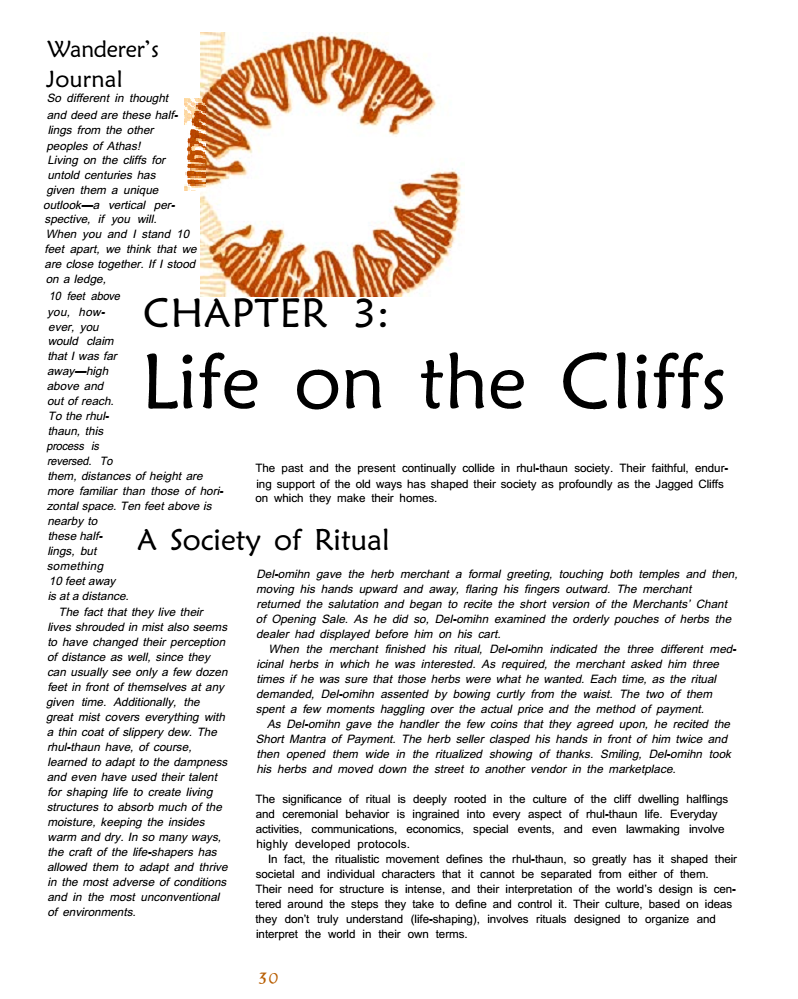
You may notice that the text on the sidebar is so tight that they sometimes manage only a single word per line. You may also notice from the interaction presented at the start of the chapter that life in Rhul-Thaun civilization would be brutally annoying to roleplay.
The rhul-thaun use ritualized ceremonies and practices for every sort of interaction. major events such as weddings, legal disputes or political activities can take ages just from the layers of formality involved. Even minor interactions involve extremely specific protocols.
Life-shaped creations especially involve rituals, not just making or caring for them, but every aspect of using them as well. Some of these rituals are half-forgotten techniques for the proper care and maintenance of a particular life-shaped creature...but many are pure nonsense (or even worse might shorten the lifespan of a life-shaped creature).
Other than ritual the main thing that separates rhul-thaun life from other cultures in Athas is the vertical orientation of their life and architecture. Since they insist on clinging to the cliff-sides horizontal space is at a premium so most Rhul-thaun cities are built largely vertically on giant ledges or along the rim of the cliffs. Climbing is an essential skill and professional climbers and windriders fill the role of cowboys in rhul-thaun culture: exploring unknown areas, hunting dangerous prey or gathering essential resources from remote areas of the cliffs.
Like a cyberpunk dystopia "height" in a city is also associated with wealth and value. The elite and wealthy live higher up in the city with the lower classes living near the base. The combination of vertical orientation and heavy fogs that rise up from the base of the cliffs means that the halflings are used to dealing with things at relatively short distances and to them they consider things to be farther away than most other species (much like normal humans consider a 20 foot walk a trivial distance but 20 feet in the air quite high).
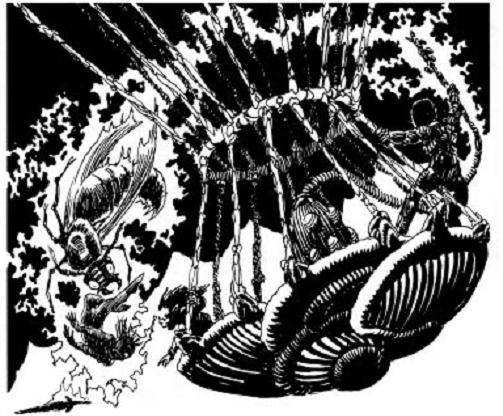
Life Sciences

The halflings have a life philosophy similar to Athasian dwarves (although less specific and obsessive), believing that life is pointless without a purpose. Just as an ecosystem is formed of many creatures who take specific roles: the plants gather energy and water from the sun and soil, the insect helps the plants to breed, the herbivores eat the plant and in turn serve as food for the carnivores, who then die and serve as fertilizer for plants. Of course, on Athas plants, insects and animals all pretty much life by killing and eating one another.
But to the rhul-thaun society is like an ecosystem and its important for each person to know their place in it. Without a role, or a purpose there is no point in living. Each individual seeks to understand what they contribute to their city and each city has a method by which it contributes to halfling society as a whole.
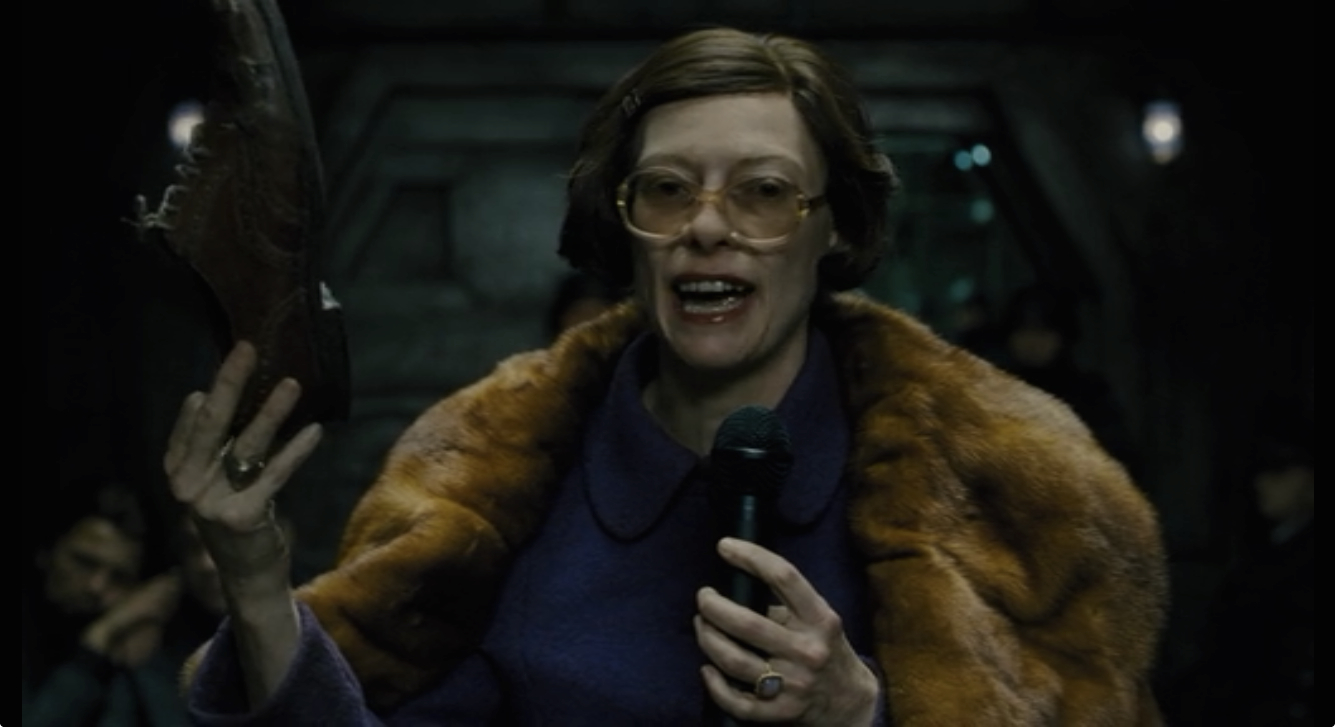
Be a Shoe
This is one of the reasons they're still clinging to the return of the High Lord. With the end of the Blue Age the rhul-thaun no longer knew what their purpose as a people was in the new world and when the High Lord left he promised that he would return with information on the changed world and would give his people their new purpose. Without him they are left adrift with no larger role in the world.
Finally, the last important element of rhul-thaun philosophy is respect for life. Although they'll eat meat, shape living things for tools and homes they still see themselves as caretakers of life rather than masters. They believe that life should never be ended without purpose and so things like hunting for pleasure or using animals for entertainment such as pit-fights would be abhorrent to them. Even killing "vermin" like insects or rats are done only if absolutely necessary and special "life-taking" rituals must be performed before and after killing a living thing.
This respect for life is one of the reasons that the rhul-thaun don't have much respect for psionics or elemental magic: they consider the forces of life the most powerful things in the world and thus life-shaped technology must be the highest achievement (ignoring of course that magic and psionics are actually quite a bit stronger in most cases).
More on halfling life coming later.
Halfling Government
Original SA post
Windriders of the Jagged Cliffs
Part 4: Halfling Government
So, want to hear about awesome heroes fighting psionic sand-sharks and chopping evil sorcerers in half with jawbone axes while wearing armor made from a giant bug's face? No?
What about moderately cool ancient bio-engineering? Not yet?
I know what you want!! You want to hear minutiae about halfling government!
Well, you're in luck.
Rhul-Thaun Clans and Leadership
Jagged Cliff society is divided into extended families or clans. Marriage is common within clans (being large enough that you're usually just hooking up with a 3rd great nephew or something) and they're more political groups than anything else.
Then we're told that apparently Clans are a fading notion anyway and most people care more about the community and city they live in than the clan they belong to. Despite this, the book will continue to harp on about Clan structure and leadership for quite a while.
Each Clan is led by a leader or a group of leaders called a Har-Etuil who operate out of a central base of operations called a clanhouse. Don't you love it when books switch pointlessly between unpronouncable gibberish and "ordinary word + other ordinary word" naming formats. Quick, take the Dhak-Ma-Koth-Ma to the "housetree"!!
Immediate family members are close and usually will share similar occupations (families of herders, herbalists, etc). In other words pretty much the same as families in most any other culture. Ah, but don't get too complacent: elder family members are honored and given positions of respect! Younger family members love to hear stories told by older family members! Did you know that marriages are formal events, filled with long rituals!? CAN YOU FEEL THE CULTURE COMING ALIVE AROUND YOU!?
It also notes that male and female rhul-thaun are treated with absolute equality as halflings have relatively minimal physical differences between genders (beyond the obvious).
The next section (about 5 paragraphs after the word is first used) is about the Har-Etuil which apparently means "Judgement Makers". Apparently they hold meetings with each other twice a year in the halfling capital of Thamasku. however, their primary day-to-day work is as a judge or arbitrator. Halfling society has no capital punishment but does banish murderers (which they consider the most serious crime) to the swamp at the base of the cliffs...which is basically the same thing. They never use imprisonment as a punishment, apparently punishing only with things like labor or forced restitution.
Also rhul-thaun police look goddamn ridiculous:
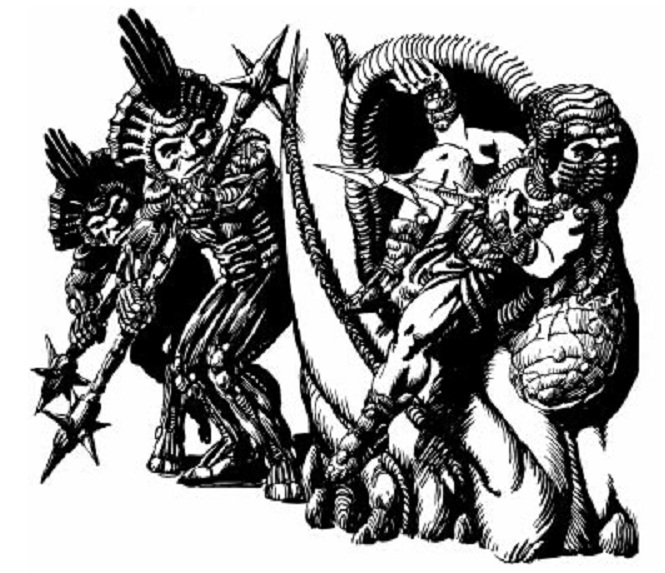
God I miss Brom
After the dry description of halfling government, let's have some fun:
Economics!
Not being a part of either the current era where metal is scarce or the Green Age when it was plentiful halflings do not use metal coins or ceramic bits. Instead their money literally grows on trees!
Well, it used to. Unfortunately no one knows how to cultivate the coin-trees anymore and thus there are a shortage of halfling coins (called ghav-egoths), which are a kind of scale-like or shell-like disc. Because of the critical shortage of ghav-egoth (shortened to "ge") coinage most trade works on the barter system. They perceive little value in gems or "precious" metals like gold and silver, although they might appreciate the aesthetic value of a piece of jewelry enough to value it. The rhul-thaun in general do not mine or work with metal at all and while they do not use stone or obsidian tools they do have life-shaped products that fill the same niche.
Want to know how much a government clerk makes in ghav-egoths every month? Well then have I got the chart for you:
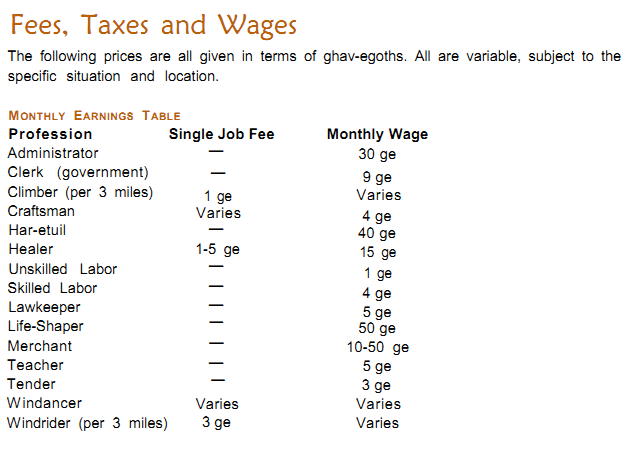
Note that only two of the entries on the chart (windancers and windriders) are likely to be the professions of player characters...and their entries aren't exactly helpful. But hey, did you know that taxes are collected bi-monthly and typically amount to between .5 to 3 ge a month!
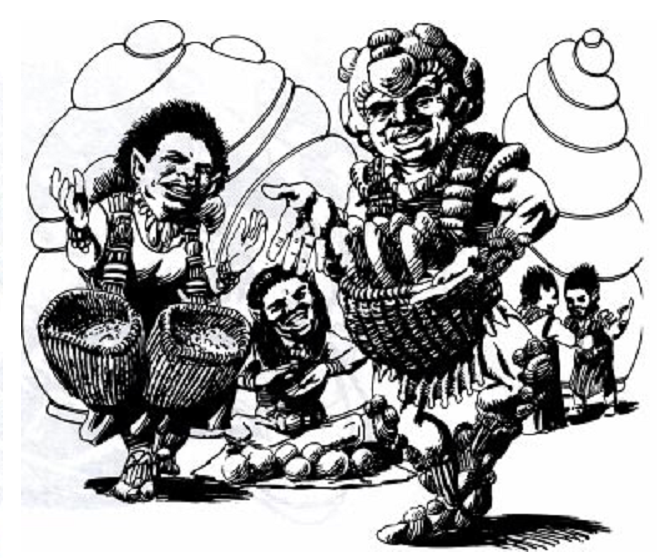
Have I mentioned how much I miss Brom?
Occupations
Next we'll take a look at the different occupations in halfling society:
* Climbers : Hey, you remember how Climbers were prominently mentioned in the first chapter? Then mentioned again in the kit for Climbers called "Climber"? Well, here we've got 7 more paragraphs about god-damn climbers! We get it!! THERE'S A LOT OF CLIMBING GOING ON!
The only notable bit in this half-page long entry is that it mentions that climber hunters and gatherers are a relatively new thing in Rhul-Thaun society as only in the last generation or so have they started to have too many mouths to feed to satisfy their needs with life-shaping.
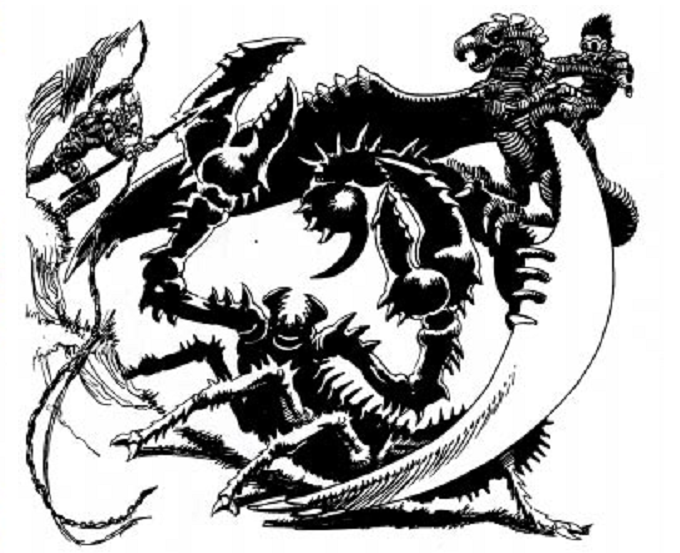
I miss Br...okay I admit this image is pretty cool
* Healers Given how rare priests are in rhul-thaun society they mainly rely on non-magical healing. Generally speaking the healers of the rhul-thaun are much more educated about health and well being than those in the rest of Athas, and so despite the lack of magical healing the halflings generally live much healthier lives.
* Lifeshapers : Life shaping is the most revered and honored profession in halfling society because so much depends on the mastery of the life-shapers. Which is why it sucks that none of them actually know what they're doing anymore. Oh, they still can grow the meat-bushes and tend the glow-sphincters just fine...but that's just because they saw their master do it who say his master do it who saw her master do it and so on and so on. The art of life-shaping is over 10 thousand years old and the actual principles and theory behind it have been lost for most of that time. With each passing generation someone didn't get quite enough lessons on how to gargle the flargle on the screaming eyes and now no one knows why they aren't screaming quite as loudly as they used to.
Of course, the Lifeshapers will never let the rest of halfling society know that. They operate somewhere between a cult and a secret society. Their treatment as the elite and the very real dependence the rhul-thaun have on them means that most lifeshapers are arrogant asshats (at least they have been since the haberdashery womb started pumping out nothing but asses and no one knows how to make it stop). They have the ability to more or less dictate policy to the clan heads (although the average hobbit on the street doesn't know this) and since they have a monopoly on essential goods they can charge whatever they like for them, manipulating the economic side of halfling culture as well. Despite that they're keenly aware of just how much knowledge has been lost and desperately guard what remains. Even the possibility of finding lost life-shaping techniques would be a priceless treasure.
A Lifeshaper must also be "accepted by the fundamental forces of life". An apprentice lifeshaper is placed in a "womb" and if they are accepted then the womb nurtures and sustains them until they are removed...if the womb rejects them then they are spat back out and ejected from the order. Once accepted lifeshapers live practically monastic lives away from the rest of the rhulthaun...and visually they're distinct because they're covered in life-shaped grafts and symbiotes.
This is also where we're given our first glimpse into how life-shapers shape-life. The process largely involves a substance called "pith" which is carefully mixed with other raw, primordial ingredients according to ritual traditions which usually take 3-10 weeks (or longer for bigger organisms).
* Scholars and Teachers ; Those who can't life-shape, teach. Although as a general rule the rhul-thaun are better educated than your average Athasian they still aren't that great about academics. Most rhul-thaun can sign their name and read shop signs but that's about it. They don't have books, writing only on scrolls made from extruded worm-silk and even then actual literature is practically unknown. There's a few journals, a lot of historical records and maybe a bit of science (although texts on lifeshaping are never available for the public). Teachers are more caretakers for the very young, bringing them into their homes and teaching them the basics of things like simple reading and math, how to climb and how to interact with common life-shaped animals or products.
* Tenders : The rhul-thaun equivalent of a farmer, this is the most common profession for the rhul-thaun. Their job is to make sure life-shaped creatures stay alive and healthy. They know nothing about actually making them but they know enough to feed, water and harvest from them. In addition to helping to produce basic goods like food, tools, leather, cloth, etc they also can be sort of construction workers: keeping life-shaped buildings alive to grow while the life-shapers themselves prune and direct their growth.
* Windancers: Part parkour artist, part busker. Imagine if that guy who painted himself silver in Times Square also cartwheeled across building roofs.
* Windriders: Cowboys with wings. Like Climbers and Windancers the book's already covered them fairly well...and frankly the concept doesn't need much elaboration. It is pointed out just how cool the rhul-thaun think the windriders are. The lifeshapers and haur-etil might be more important, but everyone wants to grow up to be a windrider when they were a kid.
Wind-riders carry out three main tasks: gathering medicines and food from the forests on the cliff faces, hunting (for food or safety) flying creatures of the cliffs or serving as couriers or escorts for those traveling between cities (this in particular often involves the largest wind-riding mount: the soar-whale).
* Criminals: Criminals do exist in halfling society: thieves, spies, blackmailers and even assassins. They've even got a criminal guild in Thamasku, just like a proper city. The most notable criminal element are the terrorists who call themselves the Chahn. The Chahn want to overthrow rhul-thaun society, seeing it as isolationist, hidebound, ignorant and more concerned with the status quo than the good of the people. Of course, they're absolutely right but sadly a lot of them also reject the value of halfling life and are quite willing to kill to try and make their voices heard. There's also a fair amount of "young rebels" who would prefer non-violent means to bring about change.
Architecture:
As you would expect rhul-thaun architecture has kind of a biological, Giger-esque element to it. Lots of curves and bulges rather than hard angles. There are two types of building: the first is a kind of coral-like building material called nen which grows into the desired shape and then, essentially, dies and solidifies into its new form. The second (and much more expensive and valuable) is rahn-rath. Rahn-rath buildings remain alive after being grown and thus can be altered later on with careful manipulation and maintenance and it can repair minor damage to itself. However, if a living building starves (or dies due to fire or disease) then it'll become brittle and crumble. You can't neglect a living house.
Language
This is one of those sections I find most annoying in old D&D books (and settings that aped D&D). I can understand throwing out some naming suggestions but do we really need to learn about how the rhul-thaun love to insert "h"s into their words or way clan names are passed down?
One thing it does provide is a short list of terms they've been using fairly shamelessly so far:
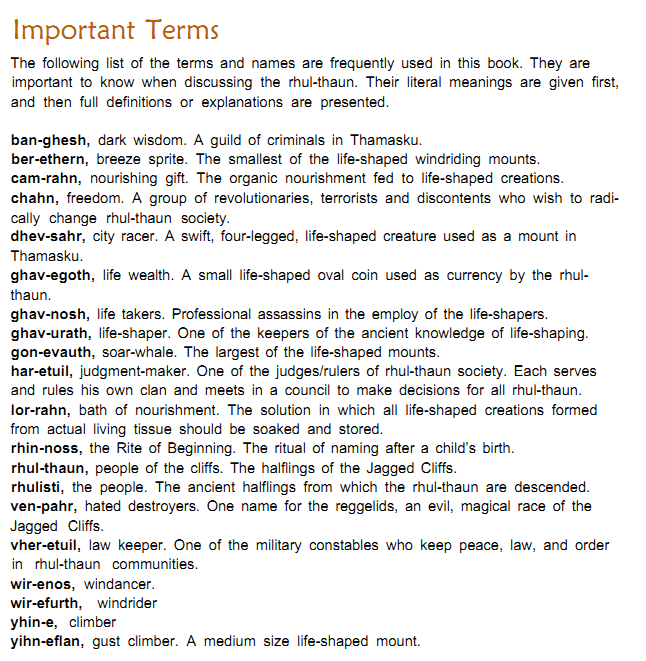
Next: living on the ledge!! (i.e. rhul-thaun cities).
Little Towns On The Cliff
Original SA post
Windriders Of The Jagged Cliffs Part 5:
Little Towns On The Cliff
So, this section will be pretty quick, because I don't think anyone cares about halfling population statistics or GDP. This chapter deals with the vertical cities that dot the Jagged Cliffs.
Here's a vertical map, showing the relative elevation of the different cities (horizontally they're often quite far apart).
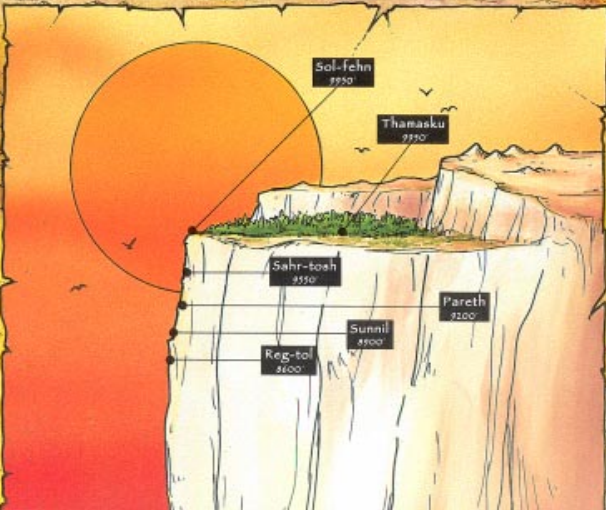
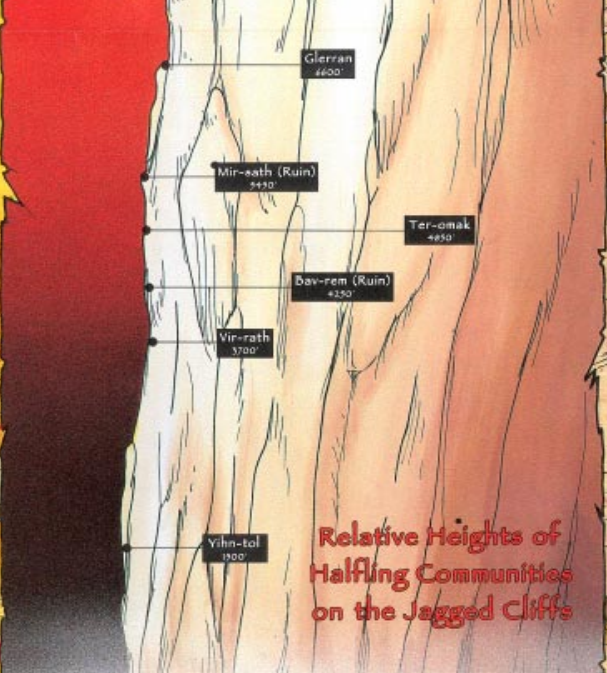
Thamasku
Thamasku has two notable features. First, it is the halfling capital and by far their largest city (12,000 people). Second, it has the distinction of actually being built on top of the cliffs rather than stuck on a ledge looming over a mile-long drop.
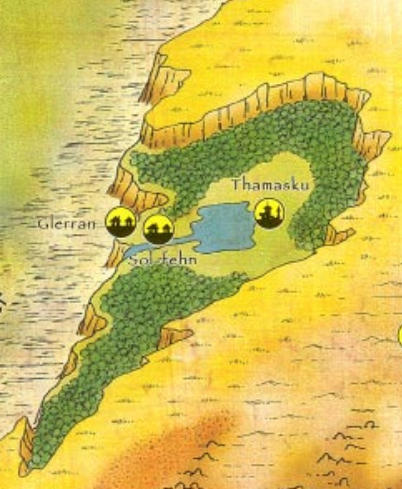
That's because Thamasku is actually the only remaining city from the Blue Age, being the remnants of an ancient Rhul-thaun metropolis built on the island chain that would eventually become the Jagged Cliffs. That means that the Rhul-Thuan took a look at Thamasku with it's flat ground, plenty of room to stretch your legs and minimal risk of falling to your death and decided..."naaaah". As you can see from the illustration there's actually a huge tract of arable land around Thamasku (according to the map scale its about 100 miles across) and with a population of only 12,000 people its hardly overcrowded up there...the entire halfling population of the Jagged Cliffs could pretty comfortably live in and around the borders of Thamasku.
But why do that when you can live right on the border of nothing at all.
Being in the center of a forest means that Thamasku actually uses lumber and so there are wooden buildings in addition to those made from life-shaped materials. The city is located on the borders of a lake which empties over the edge of the cliffs (because the authors don't really get geography sometimes) which the halflings sail on in wooden boats, as the means of creating life-shaped watercraft have been lost. Which is a shame, because apparently they looked pretty awesome.
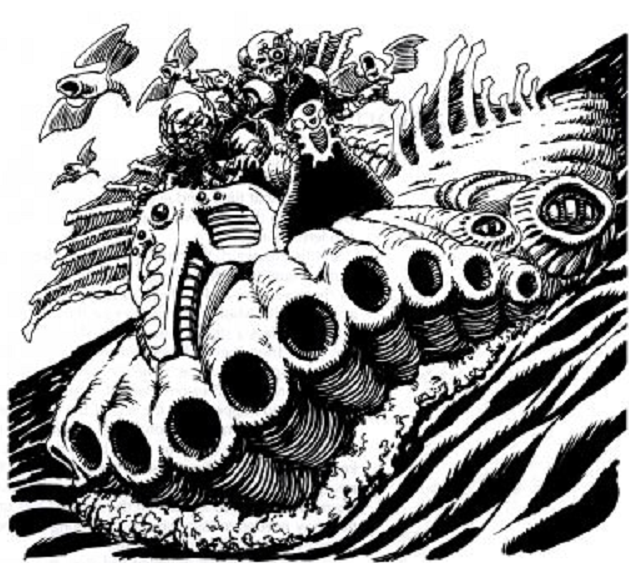
Thamasku is, culturally, more conservative and clan-focused than other cities, probably because this is where the most clan politics happen and the law-making Conclaves gather. The whole place is the economic center of Rhul-thaun society, so much so that it even has its own thieves guild! Although the ancient life-shapers who built Thamasku were masters of the forces of life itself they knew shit about city planning. That's why this is what Thamasku looks like:
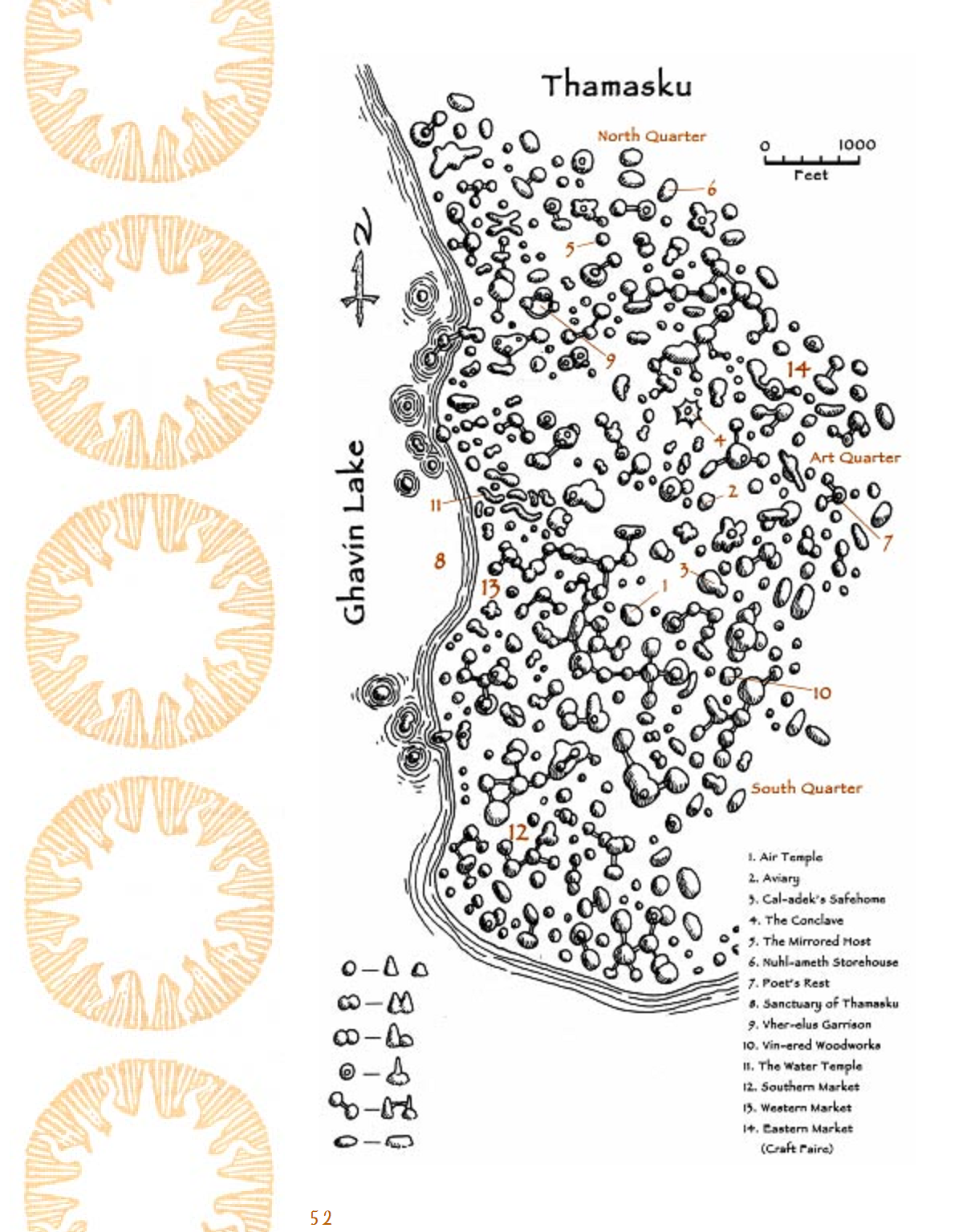
Beyond that, Thamasku has a few notable places. It features the largest Air elemental temple (and in fact, the largest temple at all) in rhul-thaun society. Despite this it still has less than 20 priests and its main function is as a resting place for windriders and their mounts. The air priests see windriding as a way of communing with the element and therefore consider all windriders "holy men" of a sort. The second largest temple is also here, a water temple located at the edge of the lake itself. Of course it also has the largest Life-shaper sanctuary, submerged underneath the lake and the entire structure is alive, its gills providing air for itself and the life-shapers who live there. In addition to Thamasku proper there's the tiny village of Sol-Fehn which is really just a remote section of Thamasku that serves as a transportation hub for those coming up from or going down below.
Pareth
The second largest halfling community is Pareth, home to about 3,500 people. The city is known as being particularly friendly to windriders and almost every business gives preferential treatment to them. It also has the second largest life-shaper sanctuary, bored into the side of the cliff by (now lost) life-shaping digging techniques, making it the only existing subterranean rhul-thaun structure (really...not only do halflings refuse to life on flat land, they won't maybe dig a bit inside the cliffs too?)
Glerran
While Pareth is the village for windriders, Glerran is the village for climbers (because apparently you've got to have a theme). The village is home to about 2,500 inhabitants. Beyond catering to climbers it really only has two notable features:
First, its home to the only full-fledged psionicists in rhul-thaun society: a pair of twins named Kal-Odot and Fren-Anan. In addition to being powerful psionicists, they have a special talent which allows them to communicate telepathically at all times and (by agreement) even swap minds. They are both self-taught and have used their psionic abilities and cunning to rise to great power in the city (one serves as the city administrator while the other serves as a false critic and opponent).
Second, it is home to a temple of elemental earth (the largest of its kind) where the priests engage in a ritual of "dancing earth" where the clerics use their powers to animate stones and knock them together, annoying all of their neighbors. The place was founded by an exiled air priest who rejected the air and began to worship earth. He was cast out into the deserts east of the jagged cliffs where he was eventually caught by a group of non-halfling bandits who began torturing him. A pyreen noticed and slew the bandits, saving the halflings life. Among the bandits equipment the earth priest found a wand of Animate Rock, which he took as a sign from his element. He returned to halfling society and founded the earth temple in glerran, using the wand for the rock-dance once every 10 years. Unfortunately, the priests of the temple are unaware that the wand has only two charges left. Apparently even the few clerics in halfling society don't actually know how to craft magic items.
Sahr-Tosh
Sahr-Tosh is kind of a terrible place to live, probably why its less than 2,000 people in all. The place is more exposed than most cliff communities and built in a particularly storm-prone location. The place is constantly battered by storms and no real explanation is provided as to why anyone would choose to live here...its not known for any kind of essential resources nor does it seem to sit on any vital trade or travel routes.
Oh, and pterrax riding pterrans live dangerously nearby and are quite happy to snag halfling climbers.
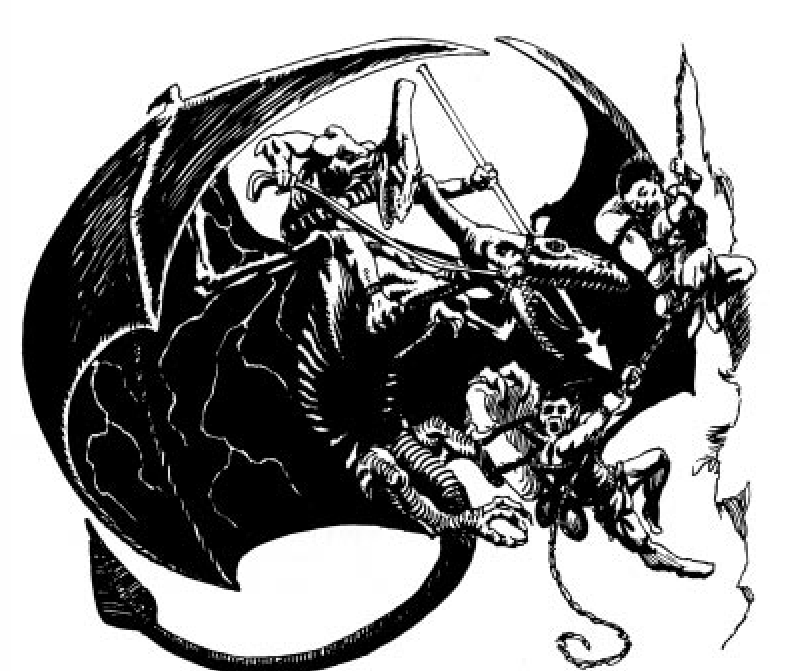
Why do we live here!?
In addition, the life-shapers of Sahr-tosh do not even keep up the pretense of political neutrality as the city administrator is also the head life-shaper. The life-shaping sanctuary is far larger, relative to the village's size, than any other and the life-shapers take the opportunity provided by being basically the rulers of the city to perform their most dangerous and morally questionable experiments here. They even have their own life-shaped assassins called the ghav-nosh (takers of life) that they use to eliminate their enemies.
In addition to the main shaper sanctuary there is the Stormtower, a kind of life-shaped prison. It holds 14 pods containing unknown, but apparently powerful, life shaped beings. No one knows anymore what is in the pods or how they could be opened safely (assuming thats even possible) and so they are kept here.
So yeah, Sahr-Tosh is a shithole.
Yihn-Tol
Before Glerran took over that role Yihn-Tol was the village that most suited climbers. Now its smaller (only 1,800 people) and no longer as important. It is the lowest halfling village and therefore the closest to the swamp and the effects of Rajaat's Curse, so mutations are especially common here. And of course the swamp is full of death-monsters who are quite happy to try and climb up the cliffs to eat some halfling faces. It is also the first target of the Reggilids (you'll find out about them later) and assaults by the thri-kreen empire to the west.
Basically, Yihn-Tol is the canary of the Jagged Cliffs, its there to hold the line against all the horrible stuff and once it finally gets torn off the cliff-face everyone else knows shit has gotten real bad.
The place is under such danger that there is no life-shaper sanctuary here. Life-shapers are flown in when needed to repair buildings (especially the city's walls, which are a unique feature among the halflings) and then flown out again once their done. Everything else must be imported.
Almost as bad as living in Sahr-Tosh.
Ter-Omak
The only notable feature of Ter-Omak is that it is home to a Hatfield/Mccoy style feud between two clans.
Vir-Rath
This village used to be supplied with water from huge, organic pumps...but of course the pool that they drew from has run dry, no one remembers how to repair them and its too costly to make new ones. So water has to be physically carried up from lower sources. At least its not Sahr-Tosh.
Sunnil
One of the smallest ledge-villages, only housing 1000 people. That's about all that's worth knowing.
Reg-Tol
The smallest full-fledged village (800 people), it used to be a luxury retreat for the rich and the traditional home of the High Lord. But since there are no more High Lords its now just a small, fairly nice little village.
Bav-Rem
A little village only notable for the fact that everyone is dead now. Although no one knows it yet, Bav-rem was the victim of a life-shaped experiment gone awry that produced a The Blob, which devoured everything organic and then retreated to a nearby cave to rest off its big meal. The place is basically a big plot hook as the creature will eventually emerge to feed, or maybe even reproduce.
Oh well, everyone may be dead...but at least its not Sahr-Tosh.
That's all the cities, next the low down on the life shapers.
Bioengineering for fun and profit
Original SA post
Windriders Of The Jagged Cliffs Part 6:
Bioengineering for fun and profit
So now we get to the part of the rhul-thaun that's actually a little bit interesting: life-shaping.
First thing we're told is that player characters should not be allowed to be life-shapers: the skills involved are too complex, lengthy and restricted to be available to adventurers. So that's at least a 50% reduction in interest right there. And admittedly, its not like Life-Shaping is all that impressive to begin with...once you get over the novelty of it its easy to realize that advanced psionics or arcane magic leaves it in the dust and even basic stuff like elemental clerics are going to be able to pull off much more impressive shit than your average life-shaper.
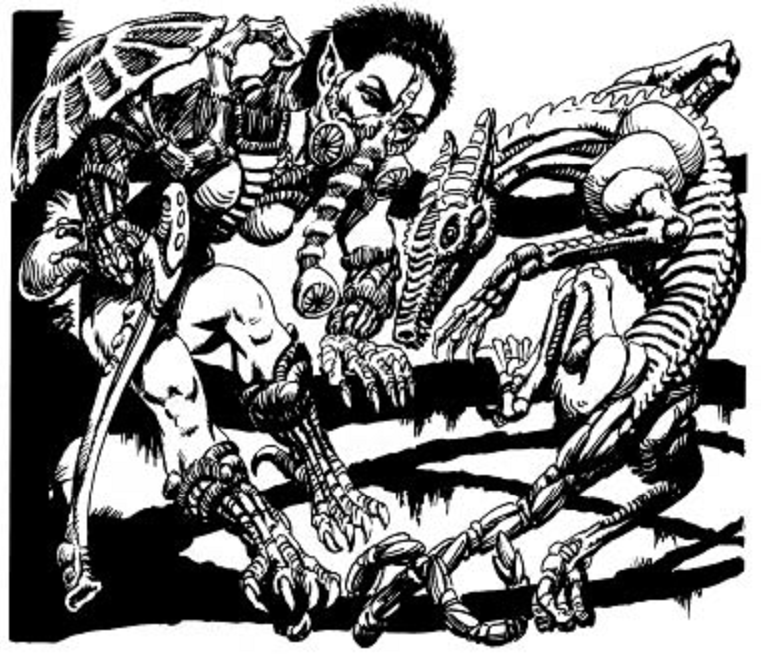
This is the life-shaped equivalent of this guy
Life Shapers in Society
The book can't really seem to decide whether or not life-shapers are assholes. On the one hand it stresses many, many times that lifeshapers absolutely respect all life and consider their skills an awesome gift and responsibility...but then we're basically told that almost all life-shapers are jerks pulling the strings of Rhul-Thaun society to suit themselves and are more or less a bunch of arrogant little bastards. The only life-shaping sanctuary represented as "good" are the shapers in Glerran who are on the verge of outright rebellion against the traditionalist shapers in Thamasku and are straight-up funding anti-shaper groups in Sar-Tosh.
Despite this, the shapers are granted a huge amount of reverence and respect among halfling society and it isn't hard to see why: they provide all the necessities that keep the cliff communities going like food, transportation and even buildings. Indeed, the entire cliff-dwelling schtick wouldn't work at all without the shapers to provide food that the halflings can't farm on cliffsides and flying creatures to allow the halflings to get from place to place.
A big deal is made of Gil-Ogres, the second-in-command of the lifeshapers of Thamasku (and thus the second in command of basically all lifeshapers), who has been pushing for more and more power for lifeshapers in order to "restore the glory of the past" and, of course, get power for himself. He fosters the belief that life-shapers are superior to other halflings and that the only way to try and regain some of their former abilities is to utterly dominate rhul-thaun society.
But here's the thing...don't they pretty much control everything already? Literally everything from clothing to buildings to food is produced by them and their creations, they have a monopoly on literally every important product and its already stated that the clan leaders will pretty much bend over and kiss their own asses if the life-shapers tell them to, because if they don't then the shapers could simply say "no more food for you until you agree."
So what exactly is it Gil-ogres and his cronies want? More paperwork? They can already pretty much make any demands they wish and its clear that this has been the status quo for centuries if not millennia. The only thing they aren't involved in is the day to day problems of running a city or clan and why would they want to bother with that? A big deal is made of all the scheming and planning going on for gil-ogres bid for power but its not really clear what more the life-shapers could do to dominate halfling society. Do they just want bigger hats?
It even notes that life-shapers have threatened clan leaders with the possibility that they possess a virus that would kill all life-shaped creations. Of course this is false, and ridiculous, considering that no one would have more to lose from that act than the life-shapers themselves.
The only thing that is mentioned as being forbidden to the lifeshapers is experimenting with incomplete or lost life-shaping rituals to try and recreate them...and of course they do that anyway.
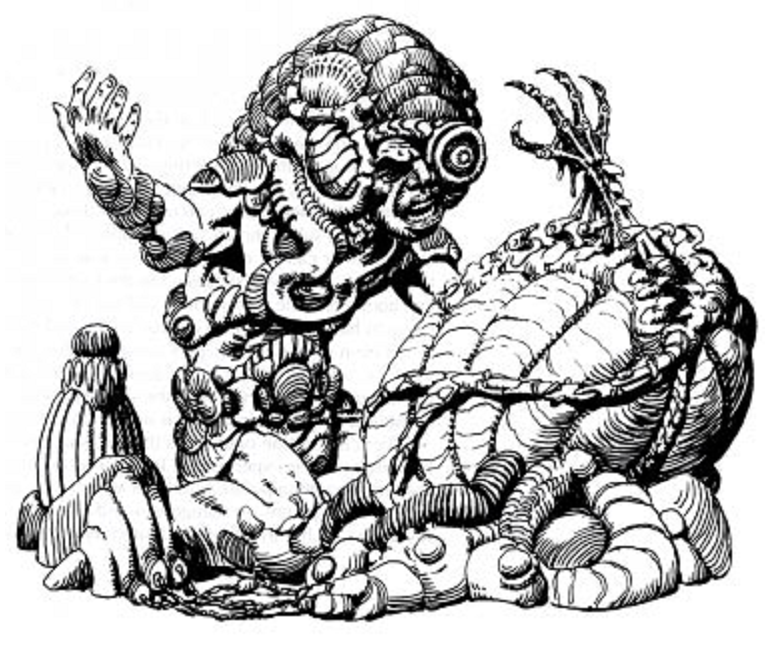
I'm sure he knows what he's doing
How Does Life-Shaping Work
The ancient Blue Age halflings started their life-shaping with the discovery of a simple form of coral ("a porous rock-like plant"). It was easy to manipulate and very hardy and so with pruning or growing techniques they could shape it into tools or structures.
Step 2: ????
Then they could manipulate any organism into just about anything.
That's more or less as much detail as we get. The "building block" of life-shaping is a substance called Pith, a kind of primordial soup that contains the basic nutrients and substances common to all living things and takes the form of a clear, syrupy liquid. "various processes" stimulate Pith to produce specific organisms or creatures.
There are three types of life-shaped creations: Creatures, Products and a third type that isn't clearly classified (basically something that's alive but not capable of any kind of independent existence). Creatures are actual animals or beings that have been produced by lifeshaping, they're usually mobile and capable of at least some form of independent action or thought (although they're not sapient). Products are actually be byproducts of other life-shaped creatures (for instance arrowheads produced by a gecko whose scales have been specifically engineered to be hard and sharp and to shed). Products aren't alive and thus don't need to be fed or tended. The third category (things like their living buildings) lack any ability to move, act or think on their own but are still technically alive and so require nourishment and tending of some kind.
A common "subtype" are grafts which are symbiotic organisms designed to become a part of their hosts and draw nutrients from them, in exchange for performing some kind of useful function. Usually they fall into the third category, but some grafts count as separate creatures.
Because they are alive, creatures and (unnamed third category) have hit points and armor class, generally between 1-3 HD. They're not very tough as a rule. Weapons and armor are tougher and can be purchased at greater expense in exchange for more HD.
Here's the sucky bit: every blow (whether you're attacking or being attacked) inflicts 1 damage to your weapon! And you thought the breakage rules for bone or obsidian weapons were bad. Fortunately weapons can heal...but only at the rate of 1 hp per day, that means that you probably have to give your weapon a week off or so after every single fight to get back to full hp! Armor is both better and worse: any damage you take is divided evenly between you and your life-shaped armor. On the one hand this means your armor is going to die very quickly...on the other you're taking half damage. If you've got the cash life-shaped armor is one of the best defenses out there. Of course, if the armor dies then it stops providing any bonus at all.
Life shaped objects have AC 8-10 for soft objects, 4-6 for tough ones and 0 for really tough stuff like armor or weapons. Generally attacking a life-shaped object on your person requires a called shot...but area of effect spells hit not only you but any life-shaped objects!
Oh, and because they're alive they also can suffer from diseases or poisons. In fact, there's a flat 1% chance per week that any life-shaped object you own comes down with some kind of infection, with a 10% chance that the condition is fatal to it! If non-fatal the disease cuts the object's bonuses in half for 1d10 days (-2 to attack for shaped weapons, and a 2 point AC penalty for armor).
Other Weapons and Armor
Not all weapons and armor of the Rhul-thaun are actually living . Most are just products of life shaped creations, for instance leather or chitin harvested from creatures bred to produce it, or creatures bred to produce horns that, when shed, make excellent spear-tips, plants that grow spiked-club branches, that sort of thing. These objects are treated as normal.
In addition they've got the weird stuff: life-shaped weapons and armor available only to halflings. Pictures are provided mainly from Psionic Artifacts of Athas which includes a lot of life-shaped gear...but oddly with very different stats or rules.
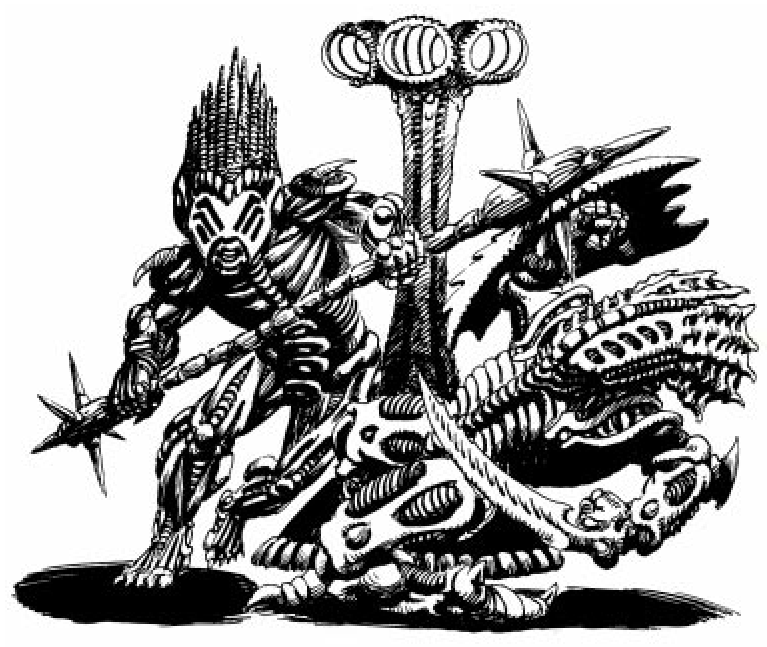
Better hope your sword doesn't have a cold
Shell Armor : The halfling equivalent of plate-mail (also comes in "half-shell" for those looking for ninja turtle references). This has 6 HD (5 for half shell) and provides AC 0 (2 for half shell). It's a living shell of hardened chitin supported and held together by fibrous tissues.
Hide Armor : This is a superior form of leather that's tougher, lighter and more durable. In addition to granting AC 7 it cuts the penalties for thief skills in half compared to normal leather. Despite being a "product" it has a listed HD of 3.
Sheath Armor This armor comes in a jar. It's a pot of paste that can be applied all over your body which will then harden in areas that you don't flex (so your joints remain free). It provides AC 4 and has 4 HD. A special version "Hidden Sheath" armor is actually a creature, reacting to blows by hardening but staying clear and flexible otherwise. It stays hard until 10 rounds have passed without an attack.
Climbers Shield This is a mushroom-looking creature whose stalk is a tentacle grafted to your back. The "cap" is chitinous and tough and it is capable of detecting attacks and moving itself to block it. Since it mounts to the back or shoulders it makes very good protection while climbing. It has 3 HD.
Spineshield : Also a creature whose limbs wrap around your arm like a normal shield but it is capable of launching the spikes on its back against your foes (but you sacrifice its shield use when firing it or smacking someone with it). It's got 2 HD.
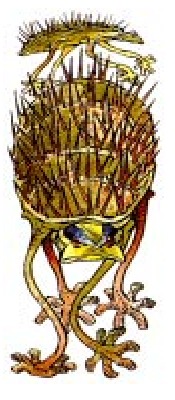
Armblade : This is a 4 HD graft that is basically an organic sword attached to the back of your arm. It does more damage than a shortsword (1d8) and you can't be disarmed and your hand remains free to hold stuff. There's also the "armspike" which is less damaging (1d6) but slightly cheaper.
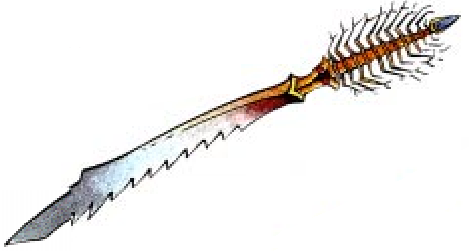
Clawgrafts: Tiny little sharp grafts which meld to your fingertips. They give you a claw attack depending on how many grafts you have on a hand: 1 claw is one point of damage, 2-3 inflicts 1d3 damage. 4-5 inflict 1d6. They have 4 HD, presumably that's per individual claw.
Deathspray: I'd just like to remind you that the halflings love and revere all life. The Deathspray is a poison squirt gun. Hitting someone with the spray of liquid requires an attack roll and it can only hit a target up to 15 feet away. The victim has to be sprayed in the eyes, nose or mouth (there's no specified penalty for this, presumably you just have to be able to target those parts of the body) and takes 1d6 damage from the caustic fluid. They are also exposed to type H poison...which is really weak. It does 20 damage (10 on a save) and has an onset time of 1d4 hours . 4 HD.
Flashlance : A spear which is actually a creature with a rapid-fire "headbutt". Essentially by squeezing the base the spear telescopes rapidly and then retracts to its normal size in a flash, inflicting 1d10 rather than 1d6 damage. It's not clear why it even has an entry for using it as a normal spear. 6 HD.
Grappler: This is sort of like the Deathspray except instead of shooting out bio-engineered pepper spray it fires a mass of tendrils which entangle and yank whatever it hits. The cords reach up to 30 feet and those entangled have a 50% chance to have their arms trapped, preventing any arm use and either way they lose Dex and shield bonuses and have a 25% chance to be pulled to the ground. Escaping requires a bend/bars lift gates roll (meaning, almost impossible for most people). The biggest disadvantage is that it takes 1d6 rounds for the tendrils to retract into the creature after the victim is freed. 6 HD.
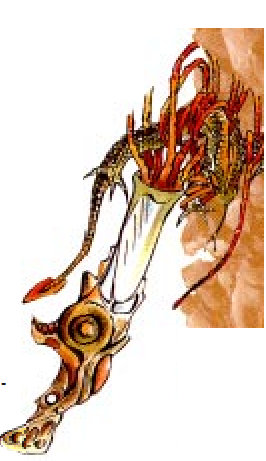
Hurling Titan : Remember mercurial weapons from 3.5? Well this is their dad. The Hurling Titan is a huge (for a halfling) maul or mace with a liquid filled core, which means it does more damage than you would think (1d8). So not very impressive (and despite the name it can't be thrown).
Life Leech: The life leech is a 7 foot polearm with a 2 inch ball on the end. It isn't actually very tough at all (3 HD) but when tapped against a creature the ball absorbs nutrients and water from them, inflicting 1d12 damage...except it also apparently injects a sedative causing any future attacks with a life leech against the target in the next 24 hours to inflict only 1d6 damage. Seems kind of stupid, maybe it was originally designed as a piece of medical equipment and the halflings just lost the manual so they've been awkwardly using it as a crappy weapon. It's noted that it requires "special combat techniques" since its too delicate to be swung hard...but no mention as to what that actually means.
Mandibles : This is just a halfling sized mancatcher polearm, except if you don't want to catch someone you can just have the thing give them a nasty pinch for 1d6 damage. Considering its meant as a way to imprison someone its surprisingly flimsy: 3 HD.

Quickstrike: The shortsword to the armblade's longsword. The quickstrike works much like an armblade except its blade is retractable, allowing it to be concealed under long sleeves and making it much easier to handle day to day life. 4 HD.
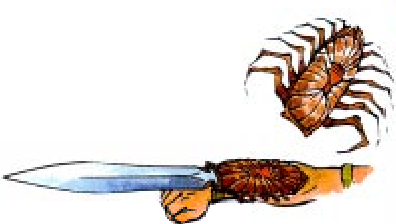
Don't ask how that's supposed to fit in that critter
Shockstick : This is an oddly adorable little creature who folds up its hard shelled body into a ball and stiffens its long tail, turning itself into a mini-mace (1d6 damage) and the first blow and every 3 strikes afterwards it'll generate an electric shock for an additional 1d6 damage. 3 HD.
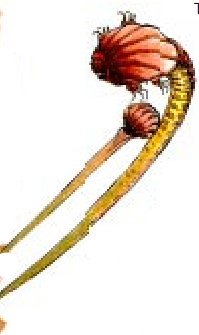
Spinethrower: The spinethrower is a kind of spiked mace which can be used as a melee weapon (1d6+1 damage) but is primarily used to launch spines as a ranged attack. Each attack launches 1d6 spines and each spine inflicts 1d3 damage and requires a separate attack roll. Spinethrowers have 1d4x10 spines and regrows its spines in 1d4 days. 4 HD
Spore Pods: Bio grenades! They look like tiny eggs and produce a 10 foot radius cloud of gas when thrown. They come in three varieties: irritating (one round stun, then -1 to hit and damage for 1d4 days), sleep (1d4+1 rounds of sleep) and Poison (2d6 minutes onset, 30/15 damage). Obviously the sleep grenade is by far the most effective.
Warstaff: The halfling answer to the gythka. The warstaff is the weapon you see in the picture of two fighting halflings above, a staff with bulbous heads that project bladed points. Inflicts 1d8+1 damage and has 4 HD.
Splitting this post in two. next one will handle life-shaped equipment and general use items.
Don't Forget To Feed Your Backpack
Original SA post
Windriders Of The Jagged Cliffs Part 7:
Don't Forget To Feed Your Backpack
Continuing the list of weird, life-shaped items. Moving on from weapons and armor to more general gear.
First it notes that the rhul-thaun can basically duplicate any regular item from the PHB in the form of life-shaped gear and products. They've got giant caterpillars that weave ropes, metal substitutes made from molded resin, plants whose outer casing sheds in the shape of belt pouches and eels that shed the belts. The vast majority of these substitutes and non-living organic products, not living creatures themselves. But there are plenty of new items that take the form of living tissues and creatures. Since they aren't designed for combat these typically only have between 4-10 hp, meaning that a single area of effect attack will pretty much kill any life-shaped items on your person.
Air Burster: A halfling t-shirt cannon. This creature stores air in a large sack and has a 6-inch pod at the other end that can hold a projectile. Usually used to launch grappling hooks, spore pods, nets, up to 100 yards. It can also be used to launch small sharp objects as a projectile weapon...although no rules are provided for this.
Air Filter : The halfling equivalent of an air purifier. It's a spongy globe that purifies air by breathing in carbon dioxide, bad smells, smoke, dust and so on and breaths out pure air. If you don't wash it every month it'll choke to death...which is kind of grim if you think about it.
Acidic Spawn: a small organic jug which, when squeezed, secretes digestive juices. The acid can only do 1 damage per round to flesh and can eventually eat its way through wood or leather but it won't dissolve stone or metal.
Bond : Organic superglue. This creature is a small tube which can secrete clear goop from what is totally not its butt. The goop is an effective organic glue that's used much like tar or similar sealants. It's organic nature also apparently makes it suitable for repairing damage to life shaped creatures, but no rules are provided for this.
Breathermask: Exactly what it sounds like. A creature that fits over your mouth and nose like a gas mask and filters air impurities and toxins (+4 to saves against gases, spore clouds, etc. It'll fit anyone smaller than a thri-kreen or halfgiant.
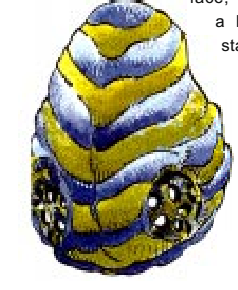
chameleon cloak: This garment is able to provide active cameo by changing its shape to match the background and light. It adds +10% to hide abilities or grants a 15% hide ability if you don't have it already. only fits halflings.
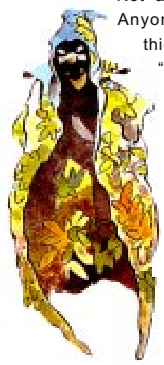
Climbing Boots : Living boots that grant +5% to climbing rolls by altering their soles to fit into footholds and cracks. It'll fit anyone below half-giants.
Climbing Gloves : Essentially identical to climbing boots, granting its own +5% to climbing rolls. It'll also fit anyone other than half-giants.
Clingbag : "leather" bags who have one side made of tissue that secretes adhesive that'll hold the bag and its contents in place (10 pounds for small bags, 40 for large). A firm pull will release the bag from the wall.
Clingpad: Double-sided organic tape. It's a strip of tissue that secretes adhesive on both sides to allow you to stick things to other things. often used to attach helpful items like glowpods.
Clingrope : Like a clingbag, but rope. Mainly it lets you just loop the rope around something and hold it in place without knots.
Coolcloak : These creatures function as a cloak which insulates the wearer from heat and directs heat from the inside of the cloak to the exterior. No actual rules are provided for what this means, which is kind of weird in Athas. They can be created to fit larger creatures but are not flexible enough fit multiple creatures after being made.
Directional Sensor: Tiny cone-shaped creatures which can sense North and whenever placed on a flat surface it'll orient itself to point its narrow end northwards.
Disposer: A combination trash-can and toilet, it takes the form of a large pod with a hole in the top. It dissolves all organic materials to both feed itself and create pith.
Dry Anchor : These blobs of living putty are good at clinging to wet surfaces and are used as handholds when attempting to climb wet cliffs. No rules are provided for how it could help you.
Drycloak: Another in the "cloak" series. Can you guess what it does? This one isn't a living creature, it's really just a naturally waterproof substance shaped into a cloak.
Gillmask Halfling scuba gear. It's a mask which has gills which provides oxygen to its wearer. It'll fit anything other than a half giant.
Glowpod: Tasteful organic lighting. These pods produce light equivalent to a heatless torch. They're the most common form of lighting in halfling villages and buildings.
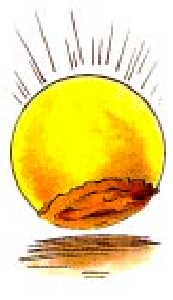
Grasping Hook : An organic grappling hook that looks kind of like a bird foot, when the open claw strikes a surface it automatically clinches and holds on with a Strength of 20.
Grasping Rod: uh-huh-huhu, "grasping rod". Basically just a grasping hook on a 10 foot pole instead of a rope.
Lifechair: Not just chairs but also couches, sofas, etc. This living furniture can be designed to be cooling or warming and forms to match your body. Just hope you can get used to your bed having a heartbeat.
Organic Locks: Organic locks are living creatures that hold doors or gates in place (although at only 1 HD they aren't all that tough). Organic locks can be "hard" locks that are designed to accept a specifically shaped key (made of unliving organic material) which will trigger the lock's "release" reflex. Apparently its possible to pick them even without the appropriate key, probably by tickling the lock until you find the funny bone. "Soft" organic locks have no "keyhole" and instead can "read" living tissue pressed against the lock and will only open if it senses the appropriate tissue. This tissue can be the skin of a particular person, an individual life-shaped object or a pre-prepared "key" of symbiotic tissue. Soft locks are unpickable.
Lockpick : an organic lockpick that tries to fill in the appropriate spaces on a hard organic lock, granting +10% to lockpick attempts.
Malleable Tool: he-hehe-he-hehe-he "Malleable Tool". This creature's body can be shaped like clay using smooth, soft strokes but resists hard blows or firm pressure. That allows you to shape it into weapons or tools such as shovels, crowbars, etc. It weighs 10 pounds and can emulate most items of that size.
Poison Nodule: These bulbs can be stuck to surfaces much like a clingbag, but much smaller. They secrete Type B poison (20/1d3 damage, onset time 2d6 minutes...what is with halfling weapons and uselessly long onset times?). They're typically stuck on the blade of weapons to coat them automatically in toxins.
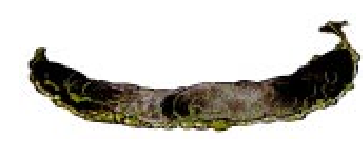
Scrubslug: This foot-long slug roams homes or businesses and eats dust, dirt, spilled food, etc and secrets a quick-drying waxy polish.
Sensor: This pair of pods that stick together but can easily be pulled apart. One is the "sensor" one is the "baffler". When separated the sensor will become alert and anything larger than an insect comes within 50 feet of the sensor it will begin to screech and cry. The sensor will deactivate if the baffler is brought within 50 feet. Since it uses non-visual means of tracking it can detect invisible creatures as well.
Shockwand: Kind of an electric eel crossed with a cattle prod. It only inflicts minimal (1d4) damage but it's often used to to stimulate the organic activity to create life-shaped objects or as a prod for bigger life-shaped creatures (remember, respect for all life). They also see some use in torture (looove all life).
Slicksuit: Full body organic suit that secretes a natural oil, making whoever wears it very slippery. It only secretes it on demand and the oil lasts for 4 hours at which point it takes 24 hours to restore its supply. While oily you can't be grappled, chained or tied up, etc.
Stealthboots: noise-reducing organic boots which add +10% to move silently attempts while non-thieves gain a 20% move silently chance.
Storage Pod: Basically the organic version of the standard chest.
Warmcloak: The inverse of the coolcloak. Obviously, there's not much demand for something to deal with cold weather except for climbers who have to brave night storms. The lifeshapers keep producing them despite the lack of demand simply so the techniques for doing so will not become lost.
Water Condenser: This creature looks like a bowl and can draw moisture from the air, collecting it inside of its bowl (its a big bowl, containing 50 gallons). It can cover itself with a flap of skin to prevent evaporation.
Watersponge: This is a sponge which can absorb up to five times its volume in liquid, releasing the liquid when squeezed.
--------------------------
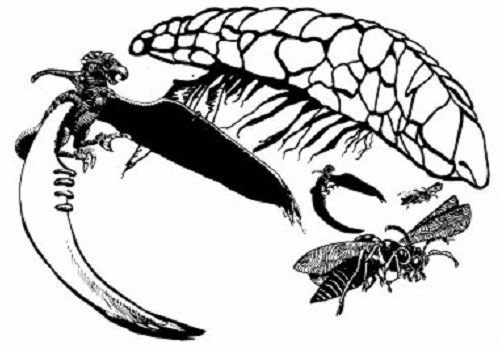
Transports
Animals bred for transportation. Notably they lack any kind of natural fears or instincts and will act only based on training or their master's orders.
Ber-ethern: "breeze sprites". Big wasp-like bugs that can carry one rider and 25 lbs of cargo. They're quite fast, flying up to 75 mph. They're also very maneuverable, able to hover, turn in place or fly straight up and down. They have a small stinger (1d4) for self defense but it has no poison.
Yihn-eflan: "gust climber". Big bird/bats. They're not as fast or agile as breeze sprites but they've got the stamina and strength to carry up to 3 halflings or one rider and 200 lbs of gear. They're also more combat capable with more HD and a double talon attack (1d4+1/1d4+1)
Gon-Evauth : "soar-whale". Basically huge organic blimps (supposedly working just from self-warmed air. They can carry a bit over a ton of cargo and flies at 30 mph. The thing has no built in means of self defense and taking more than 1/4th their hp means they begin to deflate and have to descend. These are the most common windriding mounts since they're essential for transporting materials between villages.
Dhev-sahr: The only land-based mount that only sees action in the forests of Thamasku. Sort of weird camels, capable of carrying two halflings.
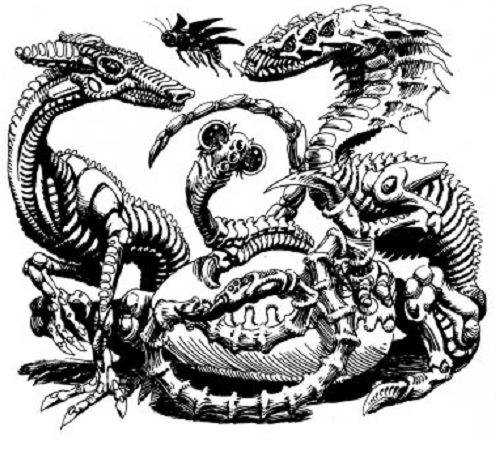
Guardians:
These life-shaped creatures are designed to help protect halflings, essentially their war beasts.
Climbdogs: The name pretty much says it all. Trained fighting dogs that have prehensile tails and flexible claws to help climbing. Their senses are twice as keen as an ordinary halfling. But you know...I think this is the first time "dogs" have been referenced in Dark Sun, Athas is kind of notable for not having ordinary domesticated animals like horses or dogs. It's also odd that all the guardians have translated names, unlike the transports.
Darkstrike: Snakelike things with large, bulbous nodules on their "face". These bulbs work like clingpads, allowing them to be stuck to walls or doors, making them kind of a living booby-trap (their dark skin makes them 90% invisible in dim lights). They can be trained to strike on preset conditions, sensing targets via sonar. Their attack does 1d8 damage and they're usually equipped with poison nodules as well.
Protector : Feline creatures who serve as guard animals and who can be trained to flawlessly distinguish between different individuals and can recognize threatening behavior towards those they are assigned to guard. At 3 HD they are the toughest guardian creature.
Shieldbug: Individually these bugs are worthless, but they can be used as a swarm (usually by windriders). The swarm surrounds their master, increasing their AC by 2 against melee attacks and when their master is targeted by a ranged attack there is a chance (% equal to the number of bugs in the swarm, between 50 to 100 usually) that a bug will intercept the attack and die (reducing the swarm by one). No rules are provided for how many bugs you get in a "fresh" swarm, but obviously shieldbugs are quite impressive...except against AoE attacks which the bugs can't defend against and will basically wipe the swarm out completely. They can also be used offensively, harassing a target inflicting 1 damage per round and forcing the victim to make a save to avoid being stunned for the round.
Watcher: A living alarm with no combat ability, it has 360 degree vision and when it observes anything it has been trained to react to it will begin keening. they don't move or attack.
Next we'll finish up the life-shaped bestiary/gear and cover a few of the weird natives of the swamps below.
Yet More Living Stuff
Original SA post
Windriders Of The Jagged Cliffs Part 8:
Yet More Living Stuff
Rhulhisti Artifacts
The Rhulhisti is the term for the "original" lifeshapers back in the Blue Age (the Rhul-Thaun being their descendants). These artifacts are life-shaped creations that are still around but no one knows how to make any more of them. You'd think they'd be placed in their own section, but instead they're crammed in here between Guardian creatures and industrial-grade life shaping. So this section is kind of a grab bag of weapons and other items.
All of these items are of exceptional ability compared to standard life-shaped items, because when you're descendants of an ancient civilization you only forget how to make the best stuff.
Darkcloak: More cloaks! Unlike the rest of the 'cloak series, this one is not self-explanatory. Neither is it actually a rhulhisti artifact. Darkcloaks are actually an accident where a living cloak has gained psionic abilities which it uses to defend its wearer, giving them a mental AC of 5. It apparently also grants a physical AC of 5...but whether this functions like armor, more like Bracers of Protection or what exactly is unclear. It's not entirely clear on whether or not the improved protection is a psionic effect or simply a result of the cloak being very tough.
Eyehand: Eyeballs that can be grafted onto your hands. You can only see through one set of your eyes at a time, making it mainly useful for things like peeking around corners. It features its own thick eyelid that'll protect it while you hold or carry things (because even the halflings are smarter than the 10-Eyed Man).
Eyestalk This performs more or less the same function as the Eyehand, just more disturbingly and you can do it while holding things. Downside, it needs to replace one of your eyes. Fitting in the eyeball the eyestalk passes inspection as a normal eye 75% of the time but comes with an extendable, prehensile 1' long stalk.
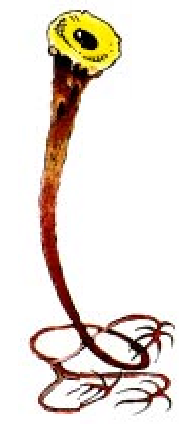
Yep, I'm sure no one will notice
Life Leech Sword: This is a functional short sword, on top of the normal short sword damage it also functions the same as the life-leech mentioned in the weapons section: +1d12 damage on the first hit as it rapidly absorbs water and nutrients, then +1d6 on each hit afterwards because of a sedative. Why would your weapon inject your opponent with a sedative whose only function appears to be making your attacks less effective? I could kind of buy it with the life leech because that never seemed like it was intended as a weapon in the first place but this one clearly is. Oh well, either way its pretty impressive for a life-shaped weapon since that bonus damage is added on top of the regular short sword damage.
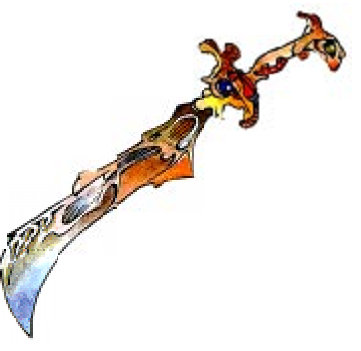
Lightning Generator This large pod builds up a store of static electricity within specialized organs and can release it as a 6d6 Lightning Bolt equivalent. The bolt is shot from a wand connected by an organic cord to the main body of the creature. The generator produces a new "charge" every 15 minutes but can only charge up if left still: transporting it ruins the recharge. Hung from a soar whale it can be moved, but even then has a 25% chance to ruin a given recharging period.
Mimicskin Like sheath armor this is a paste that must be spread upon the wearer. Once applied it responds to mental commands, reshaping the wearer's outward appearance just like the alter self spell. It can make you appear larger by inflating itself but can't (obviously) make you any smaller.
Overmind: No, its not a supervillian. This is a giant artificial brain. A life shaped computer. It's an 8 foot diameter tissue wad with a single ear and a halfling sized mouth (apparently no one thought it would ever be useful to show it anything). The Overmind is not sentient in the standard sense: it has no free will or desires and exists only to be provided information then asked for a solution or make a decision. Because of its extensive store of knowledge and massive braininess it can come to a "correct" decision 75% of the time. Only one Overmind is known to still exist (presumably it is in thamasku although this is never stated).
Recorder : Another life-shaped artifact with only one remaining copy (known as the Dal-erat, the word of the people). The recorder is a cube capable of recording and replaying sound, with each face of the cube capable of storing 10 minutes of audio. The current recording contains a message from an ancient and unknown High Lord regarding the value of life, and has never been recorded over.
Senselink: An organic cord about 3 feet long that can connect two living beings by their brains. While connected the senselink allows the sharing of sense memories (so you can't "talk" back and forth, just share things like sights and sounds). Its not clear if this only works on willing creatures.
The Womb : This is the most ancient, mysterious and important of the rhulhisti artifacts. The Womb is a creature whose body fills a 100 foot chamber in the Thamasku sanctuary. It is used as part of the initiation for new Life Shapers who are dropped into the womb and moved throughout its inner organs. Those who are accepted by the womb come out conscious (but with all memory missing of the experience) those who are not are spit out unconscious or dead. The unconscious ones are nursed back to health and rejected from the life shapers. The shapers see the womb as a way of testing whether the "forces of life" accept a new shaper...of course they have no actual idea what the function of the Womb is at all, it could be a faulty industrial plumbing device for all they know.
Engines
These are large life-shaped creatures intended to perform "industrial" scale work. They don't appear to be rhulhisti artifacts so presumably they can still be constructed.
Air Pump: Basically some lungs and some tubes. Air Pumps are normally used in underwater structures like the Thamasku Sanctuary or clearing the air in large structures that would otherwise get filled without foul odors or smoke.
Furnace : A round globe-shaped creature about 3 feet across which has an unusually high body heat (equivalent to several large roaring campfires) to provide warmth.
Motive Engine: A big lump of muscle with 1-4 arms that are pre-programed to engage in certain movements: used to run mills, pull pulleys or elevators or open big doors.
Water Pump : Like the air pump, but for water. Has several "trunks" that can be used to direct the flow of water (and which can also be attached to tubing to move it farther).
Grafts
A few grafts have already showed up among the rhulhisti artifacts, but these are the regular ones that can still be made. Grafts are life-shaped symbiotes designed to physically meld with other creatures supplementing or replacing their body parts. Since they can feed off nutrients from the host directly they don't need the same level of care as other life-shaped items (but do increase food and water intake by 10% per graft). Grafts can be removed, leaving only a slight rash that fades after 24 hours.
Cosmetic: These skin grafts are the rhul-thaun equivalent of piercings or tattoos. They don't impose any kind of burden on the host's system (no increase in food and water) and are mainly used for things like showing clan affiliation or membership in a guild or organization.
Glider Grafts : Snap-on wings that let you glide (not fly), traveling 100 feet for every 10 feet of height (requiring a minimum height of 30 feet to work at all).
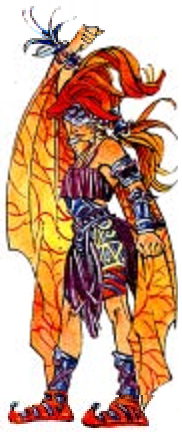
Glow Grafts : Bioluminescent patches which shed light like a torch. The raver cousins to cosmetic skin grafts.
Lens Graft: Little scraps of tissues that attach directly to your eyes (remember that removing a graft leaves a rash? my eyes are watering just thinking about it). A pair of lenses grants you the ability to see twice as far while still being able to see close up equally well.
Lightvisor : Basically an organic graft that resembles Jordi's visor from star trek. This is basically a set of low-light goggles, allowing you to see in very dim lighting (but not complete darkness).
Swim Fins: Exactly what you're thinking of. A pair of webbed extensions that graft themselves to your feet and hands, increasing your water speed and endurance by 50%.
Touch Bad Grafts : set of pads that go on the fingertips and palm, increasing your sensitivity to touch, allowing you to do things like search for traps or pick locks with a +10% bonus.
Producers
For those who don't recall Producers is a term for life-shaped creatures who are engineered to produce organic, but non-living, products that are used by the halflings. They are the most important life-shaped creations as they produce the essentials for day-to-day life among the halflings. Two broad sets are presented:
Food Producers : There's plenty more but some examples are turtle-like egg-layers called baredum, Don-egoth which are small trees that produce sweet red fruits, Chuhn-egil which produce milk and vash-erat which sprout "grains" from their body which can be sheared and ground into flour.
Textile Producers : Another staple category. The drun-sahn are snakes which shed leather, fis-evar are herdbeasts grow long wool that can be spun into fabric. The ghov-erad secret a thin film that hardens and is used to make drycloaks (it seems like a type of plastic sheet essentially).
Medicine:
Although life-shaping, in general, isn't that amazing compared to what's possible with normal materials one area they excel at is medicine. They're still not as great as a templar, cleric or druid but the medical knowledge of the rhul-thaun is much broader and more easily applied to day-to-day life (for instance, they understand germ theory and sterilization). They also have a few medically specific life-shaped creations.
Bloodclot: A sort of living bandage. Its a 3 inch patch of flesh that when placed on a wound will meld with surrounding skin and flesh, sealing the wound and restoring 1 hp. Now, here's where it gets unclear "after 1d10 minutes the wound heals completely, leaving the bloodclot enmeshed in the patient's own flesh". Does that mean that a bloodclot can heal all the damage from a wound, or is that just flavor text. I guess we'll never know.
Detoxifiers: Miscroscopic life-shaped organisms suspended in a liquid medium. When drunk they'll search out toxins and neutralize them within 2d4 rounds. After finishing their task they're flushed from the system and die.
Healing Patch: Bloodclots of extra healing. These resemble bloodclots and function much the same, but they heal 1d8 damage rather than 1 (implying that the ambiguous text in bloodclots is just poorly worded fluff).
Joiner : A graft that'll actually reattach severed limbs. The joiner is a thin layer of tissue that should be placed over the open stump of the missing limb and then the limb stuck on over it. The joiner holds them in place and facilitates the passage of nutrients back and forth and the rejoining of nerves and tissue. This isn't simple though, for 2d6 days the patient absolutely cannot move or their arm will fall back off. The joiner has a 75% success rate (dropping to 50% if the attached limb did not belong to the original patient).
Preservation Fluid: : An organic soup that prevents tissues from decaying. Mainly used to hold severed limbs for the joiner but could also be used to store damaged life-shaped creations or corpses for funerals.
Care and Maintenance of Life Shaped Creations:
Here we get a bit of info on the care of life-shaped creatures. First, we're told that they don't eat or drink normally. All living life-shaped objects subsist on cam-rahn, a nutrient solution which provides them food and water in one, and all require one "dose" of cam-rahn per HD per day (no guidelines are given on how much a "dose" actually is). Grafts are an exception, unless they are unattached. They are capable of breathing on their own. A life-shaped creature will die in 2-5 days if not fed its daily broth, and a tissue will die in 2-3 days.
We're also told that life-shaped creatures need rest as well, resting at least as much time as they spend working and no single creature can work for more than 24 hours straight. So an engine that spends 8 hours grinding, pumping or pushing needs at least 8 hours of rest. If this is violated then they lose 1d4 hit points every 4 hours of additional work.
Life-shaped tissues also must be submerged in a organic solution called lor-rahn (at least 30 minutes every 24 hours) and if they are not then there is a 20% cumulative chance that it will wither and die.
Life shaped (except the rhulhisti artifacts) have a limited lifespan, dying in 3d4 years for creatures, 1d2 years for tissues.
So, let's just summarize what a pain a life-shaped item can be. Let's take a fun item like the Warstaff. The warstaff is a 4 HD tissue. Here's a rundown on what you need to keep in mind with it:
-
The staff loses 1 HP every time it is used to attack or every time you are attacked. It heals 1 hp per day.
-
The staff has a 1% chance per week of becoming infected (-2 to hit while sick). If it gets infected there is a 10% chance that this will kill it.
-
You must supply it with 4 "doses" of cam-rahn per day (a cost of 1 ge per dose...meaning this weapon costs 120 ge per month, almost the same as its purchase price of 150 ge). If not fed it'll die in 2-3 days.
-
You must immerse it in a bath of lor-rahn for 30 minutes every 24 hours. Keep in mind that the warstaff is a 5 foot long pole, so imagine what kind of container you'll need in order to submerge it. Now imagine lugging that container around with you if you're traveling. If you skip a day it has a 1-in-5 chance of dying and will die for certain within 5 days.
Boy, life-shaping really seems worth it. Now, imagine doing that for half of your inventory.
Magic and the Life Shaped
Next we've got guidelines for how magic interacts with life-shaped creatures. The obvious is of course that, as living creatures, life-shaped creatures or tissues can take damage from harmful spells, be healed by healing spells, etc. The main purpose of the list is to provide guidelines on weirder spells. Any spell that affects plants or animals has a 50/50 chance of affecting a life-shaped being, as they are composites of both.
-
Animate Dead: You can reanimate life-shaped creatures, as a rule they're half as strong, effective or fast as a living one.
-
Animate Objects: This works on the life-shaped, even living ones (except presumably already animated ones life guardians or mounts).
-
Clone: You can clone life-shaped creations and they don't suffer the normal problems of multiple active clones.
-
Enchant an item: Apparently you can enchant life-shaped weapons and armor.
-
Forget: Simply causes a life-shaped creature to shut down for 1d8 rounds.
-
Grease: can be used to cause grafts to slide off the subject if they fail a save.
-
Haste: works on the lifeshaped. It claims it helps with things like Flashlances as well...but its not clear how.
-
Major/Minor Creation: Can create life-shaped organic products but not living ones and only if the caster is very familiar with the particular product.
-
Ottos Irresistable Dance: Can affect creatures, causing them to be useless for the duration.
-
Plant/Animal growth: 50% chance to work but otherwise functionally doubles the object's size. Although it notes that this generally doesn't improve it (although I guess you could make weapons bigger).
-
Polymorph Other: Can polymorph living life-shaped beings, a caster very familiar with a life-shaped being can polymorph something else into one as well.
-
Raise Dead: can restore life shaped beings.
-
Ray of Enfeeblement: can weaken life-shaped weapons and armor. weapons suffer -2 to hit and -1/die to damage, armor suffers a 2 point AC penalty.
-
Regenerate: repairs life-shaped beings as well. The reverse kills them.
-
Reincarnation: no effect
-
Restoration: the normal restoration spell has no effect, but the reverse kills the creature.
-
Sleep: makes a life-shaped creation limp and useless for 1d6 rounds.
-
Speak with animals/plants/monsters: no effect, even on mounts or guardians. Life-shaped artifacts with sentience may be affected at the GM's option.
-
Flesh To Stone: works normally as does the reverse.
-
Stoneskin: works on life-shaped creations.
-
Strength: improves life-shaped objects. Weapons get +1 to hit and damage, armor gets 1 point better in AC.
-
Transmute water to dust: instantly kills life-shaped creatures.
Other Races
A bit of general info that got skipped along the way. Although the halflings have minimal contact with anyone else there are a few other sentient species they've interacted with, including some that live only in the Jagged Cliffs region.
Pterrans: Dino-men who also dwell in some parts of the jagged cliffs who ride domesticated pterraxs (pterodactyls). They're not evil, but they are territorial and don't have much in common with the halflings culturally. There's been blood shed between them and the halflings and it doesn't look like they're going to sit down and chill together any time soon. One big bone of contention is that the Pterrans like stealing life-shaped creations and using them...but since they don't have the knowledge or supplies to feed and maintain them the creatures or objects will die quickly. This pisses the rhul-thaun off to no end and there have been suggestions as to the possibility of going to all out war with the pterrans.
Pyreen: The Pyreen of the Jagged Cliffs region are almost as blindly traditionlistic as the halflings. You see the Pyreen know the history of the rhul-thaun and see them as the last remnants of Athas' history, and thus they seek to preserve them. On the one hand they're the reasons the halflings haven't faced raiders, nomads or outsiders from the East and they've often served as invisible protectors of the halfling way of life. On the other hand they're also just letting the halflings squat above the poison swamp as the skills and abilities essential to their survival fade from memory and more and more ancient techniques are lost every generation. Given that the pyreen are, effectively, immortal and much, much smarter than the halflings they could certainly make themselves useful by helping to preserve their life-shaping skills, teaching the halflings to master psionics and even helping to spread the knowledge and techniques of life-shaping to other parts of Athas where such skills would be vital for restoring the world's shattered ecosystem.
But no, they'll just stay on top of the cliffs, keeping anyone from reaching the halflings from that side while the rhul-thaun are slowly killed by mutations from below and thri-kreen from the west.
Thri-Kreen: Thri-kreen are the halfling's greatest enemies. Not the nomadic, hunting obsessed thri-kreen of the Tyr region...the thri-kreen to the west of the Jagged Cliffs are an expansionist empire whose desire for conquest is stymied only by the barrier of the Jagged Cliffs. As far as the halflings are concerned the Thri-kreen are not a part of nature and should be exterminated for the sake of all other living things...of course they don't have anything like the resources needed to challenge the thri-kreen empire and can only hold their own, aided by the natural barrier of the cliffs. Better hope no PCs from the east come with a Kreen in the party.
To make matters worse the Thri-kreen have their own version of life shaping, its just instead of breeding other creatures and objects, they alter their own biology: adapting their soldiers to the conditions of the swamp, to make them tougher, stronger, better climbers, etc. Each new generation of thri-kreen is harder to fight off than the old one. And unlike halflings, the thri-kreen are making new techniques while the life-shapers lose them.
Reggelids: This is a species that lives only in the swamps at the base of the Jagged Cliffs. They resemble ugly, elongated elves with an extra finger on each hand. No one knows their origin, even they don't know because they simply seem to have no desire to pass down or preserve their own history. The only thing that they care about is arcane magic, which they are very good at. All reggelids are wizards or fighter/wizards, born with magical abilities from the effects of the swamp and increasing in power as they get older. They have an innate talent with magic items, having a 75% chance to increase the effect of any magic item they use by 25% (rounded up).
They live in simple huts, not because they lack the ability to make better conditions, but because they simply don't care to bother. Magical lore is inscribed on stone tablets and is the only thing that reggelids care about. They have little in the way of culture but never come into conflict with each other: they instantly defer to whoever is more magically adept or skilled (even marginally) and never fight and always seek to share knowledge among themselves.
They also have an odd hatred of halflings in general and life-shaped objects in particular. They've even developed a spell (Organic Disruption) specifically to kill the life-shaped. It's a 10 ft radius AoE which is a save-or-die to all life-shaped as well as any non-living organic matter. Non-life-shaped creatures take 2d6 damage (save for half).
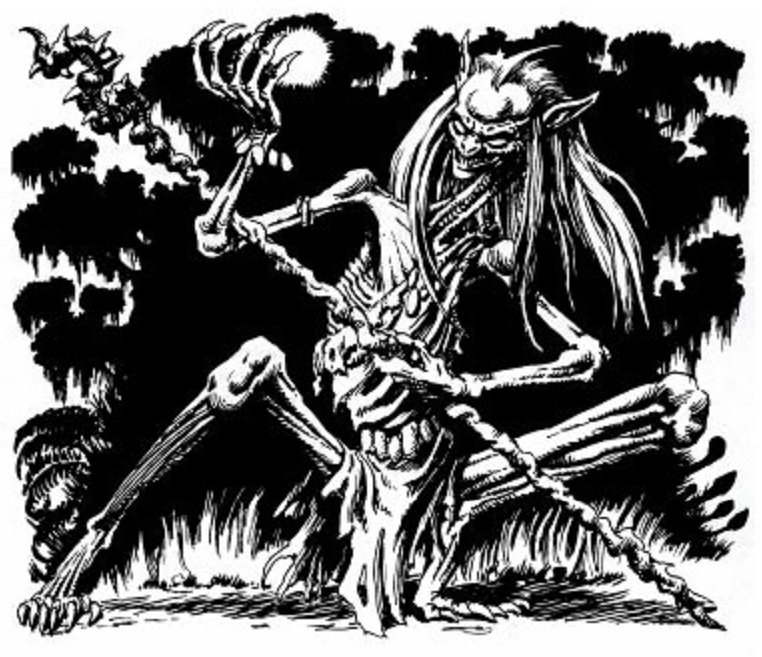
Bvanen : Despite their appearance, Bvanen are good aligned swamp-monsters. They're amphibious and live in the swamps at the base of the cliffs. Despite being good aligned they are a bit distrustful and this often leads to otherwise avoidable conflicts, especially since they look like monsters. They secrete an ooze from their skin which hardens into a protective shell and can be splashed with a claw attack to cover an opponent's limbs in hardened resin, rendering them useless. It also seals the bvanen's wounds immediately, making them immune to bleeding and just plain reduces all damage by 1.
About 1-in-6 Bvanen are decent psionicists.
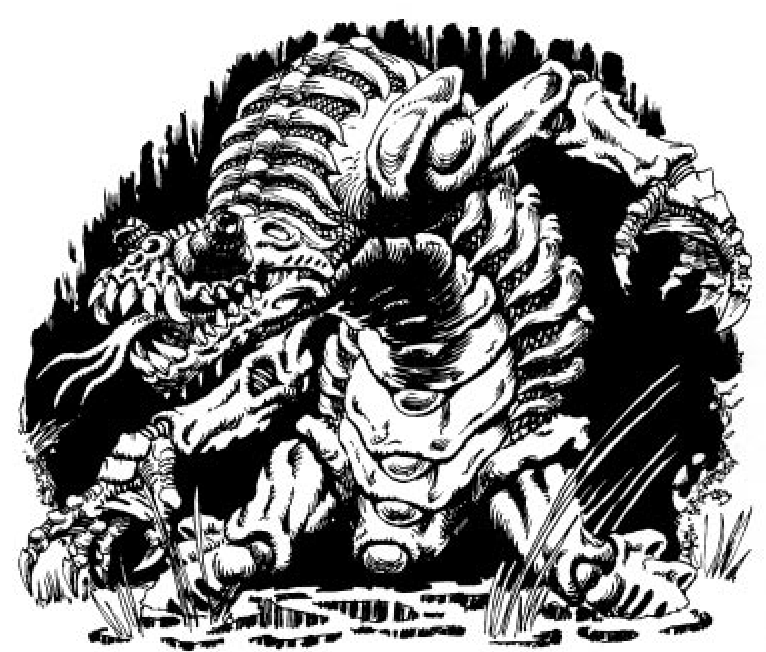
Next update should be the last, with the intro adventure " Into The Swamp "
Into The Swamp
Original SA post
Windriders Of The Jagged Cliffs Part 9:
Into The Swamp
Included in the book is an intro adventure: Into The Swamp, for characters of 4-6th level. It claims that it can be used for rhul-thaun characters or for general Dark Sun PCs.
Background:
The intro to the adventure is centered around Sahl-oren. Sahl is an explorer who has traveled up and down the cliffs, into the swamp and even beyond into the thri-kreen empire and back. He's so badass you guys.
Rumors have been passing around that he's recently discovered a super-awesome-special-total-super-ultra secret. It's so amazing you guys.
Some possible rumors are the discovery of the High Lord's mummified remains, a super powerful life-shaped artifact, the source of Rajaat's Curse or the plans for a huge invasion by the thri-kreen.
What he has actually discovered is a magical item: one designed specifically to destroy the life-shaped. He found it in the swamp along with several of his companions, who all died. The slaughter prevented him and his companions from actually recovering the item. The item is an ancient creation by Rajaat himself who, realizing that he might have uncomfortable encounters with the halflings, created the item (called little death) in order to defeat them by stripping them of their life-shaped items without killing them directly.
Apparently Sahl learned about little death while exploring Rajaat's ancient sanctuary in the swamp but was never able to reach it because of the traps and magical protections...of course if he never reached it how the hell is he supposed to know what it does or that it exists at all? Did Rajaat leave notices written in ancient halfling posted on the walls of his sanctuary detailing the function of one of his personal magic items?
Well, anyway Sahl apparently let this secret slip (despite the fact that none of the rumors are close to accurate) and got himself snatched up by the Chahn who want to force him to reveal the location of the item in order to use it in their war against the status quo.
Rhul-thaun are assumed to be interested in searching for Sahl to find his secrets, either for their own purposes or because they've been hired by a sponsor interested in his secret.
Outsiders are more complicated. Basically because they need to be safely introduced into rhul-thaun society, probably including learning their language, culture and even a basic understanding of what is going on. Then somehow they've got to get interested in Sahl and his secret. After this section the possibility of the PCs being non-rhul-thaun is completely ignored and everyone is assumed to be a halfling.
The Set Up
The adventure opens in Thamasku and assumes that the PCs have been hired by Cohg-agon, a merchant and information broker, who wants to know what Sahl does. She meets the PCs in a fancy safehome (halfling inn) called the Mirrored Host where she fills the PCs in and asks them to find Sahl, or his secret. She'll pay 500 ge per character and if they agree to an exclusivity agreement on the information she'll give them a 20% cut of any profits made by selling the information.
If the PCs agree then she'll inform them that Sahl was last seen in Glerran and disappeared 3 days ago. She'll supply transportation to Glerran as well as the names of some contacts who migh know what's happening: a tender in the village, a painter and the barkeeper at a local safehome.
One thing the PCs don't know is that Cohg-agon is deep in the pockets of the lifeshapers of Thamasku and they're the ones after Sahl's secret.
On The Trail
Traveling by Soar Whale to Glerran the PCs are guided by a windrider named Trav-osald. They leave from Thamasku and make a short supply stop in Sol-fehn to pick up supplies. The PCs are given an hour to wander the little village. After 10 minutes of doing whatever the GM is supposed to give them an Int check at -3. Anyone who succeeds will notice that they're being watched from a tower nearby. If the PCs attempt to approach the observer he'll try and flee (or if that fails) use his clerical abilities (he's a 7th level water cleric).
The guy is a secret member of the Chahn and is very ugly (just so you know he's a bad guy). The Chahn have learned that the life-shapers are sending investigators and know that the PCs have been hired by them. He doesn't have much spine though, if threatened or trapped he'll confess he's a Chahn member and was told to watch for the PCs although he apparently doesn't know anything about Sahl in particular.
If no one makes any of their intelligence rolls then everyone just wanders around town for an hour I guess.
Glerran
The flight down to Glerran is quick enough since it's just a matter of flying straight down, taking only an hour. The PCs are then expected to hit up their contacts.
*The Tender: this is an old man who tends a flock of slugs who ooze anti-biotics. He also does a bit of healing on the side as well and is an old friend of Cogh-agon, having worked for her father in the past. He knows that the Chahn kidnapped Sahl, but has no details beyond that.
*The painter: She's "very observant" and is willing to sell some info for 5 ge. Her information is pretty much useless though: she knows that Sahl had been on a trip to the swamps after some kind of relic related to Rajaat's curse (so apparently someone knew about the item already? How?). She can also show them sketches of the explorers as they left the city. This is in no way useful.
*The bartender: This is the "Mos Eisley Cantina" scene, a bar full of criminals and ruffians. He's already been threatened by the Chahn and is unwilling to share information. Before the interaction can go on too long the PCs will be attacked by 4 Chahn agents: 4th level fighters, one armed with a grappler and another with a sleep pod...which they waste by using it on the bystanders to put them out of commission. After beating the Chahn and saving the bar and its patrons the bartender will spill everything: the chahn captured Sahl after he shared that he found a secret citadel in the swamp. The main bit of info he can provide is the general route that his expedition took to reach the citadel. He thinks that the Chahn probably already left for the swamp with Sahl as an unwilling guide.
The bartender is right and since its apparently absolute impossible (as the adventure says) for the PCs to locate any other Chahn or their base in town so they have no choice but to follow.
Down The Cliff
There are two ways down:
*The first is climbing. It's easy to find the path the bartender described and pretty much requires a professional climber and probably requires all of the PCs to at least have the mountaineering skill. It takes 2 days to climb down (a day and a half if everyone is a climber).
*The second is flying, via windriding. This is obvious a lot faster (about an hour) and of course requires the funds to pay a windrider. Even if they can track down the windrider who found the citadel in the swamp originally and get directions none of them will be willing to actually land in the swamp...only set them down on the ridges at its edge.
Despite the fact that travel times vary between 1 hour and 40 hour this has absolutely no effect on any of the encounters in the swamp.
Near the bottom of the cliff is a climbing camp (along the trail). It has no real information or useful items other than perhaps as a general clue that the Chahn (or perhaps anyone else) has been walking along. Unfortunately there is a nest of cliff-kanks nearby who'll attack in groups of 3d6 (which is not a small challenge since kanks have a paralytic bite). Even worse they'll continue to attack in waves until the characters flee or all 500 kanks in the nest are gone. It's not clear how the people who camped here originally avoided being bug-murdered.
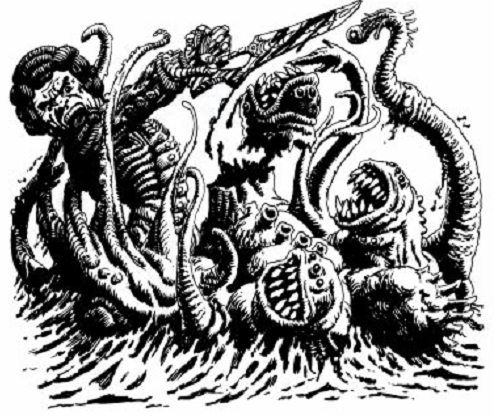
Scrotum warrior fights testicle monster. Scene not actually appearing in this adventure
The Swamp
Visibility is better in the swamp as the mists shoot up from steam pools and gather above the trees, allowing you to see a whole 2d10+10 feet. The water level is about waist-high on a halfling and includes sinkholes and quicksand. Of course, what would a 2nd edition adventure be without a random encounter table!
1-20 Quicksand: Getting caught in quicksand sinks you in 1d4+1 rounds. Attempting to escape requires assistance or a rope or branch to pull on and a strength check. Each failed attempt to pull yourself counts as an extra round.
21-30 Steam Burst: A blast of hot steam catches 1d4 characters and take 3d6 damage (save for half).
31-38 A giant crocodile
39-45: Giant frogs
46-50: Poisonous frogs
51-55 Strangling vines
56-60 Bog Wader
61-65 Hydra (I'm sure a group of 4th level characters will be totally fine)
66-70 Shambling Mound (another group murder)
71-75 Behir (and yet another)
76-80 Giant Leech
81-85 Bvanen
86-88 Will o Wisp
89-93 Reggelid
94-97 Monstrosity: a heavily mutated creature. The table for generating a monstrosity is actually larger than the original encounter table itself.
98-00 Rajaat's Curse: A random magic effect that ranges from enchanting PC equipment to forcing PCs to make a save or turn into a monster. No guidelines are provided for this.
You're meant to roll a 1-in-6 chance for an encounter every 4 hours...but we are never actually told how far the PCs have to travel from the cliffs to the citadel in the swamp. I mean, we get this map:

which has several unhelpful notations for places miles away from where the PCs will actually travel and it does have a distance scale...but good luck getting an accurate measurement from that to the winding trail, or any information on travel times through the swamp.
Then we get this map:
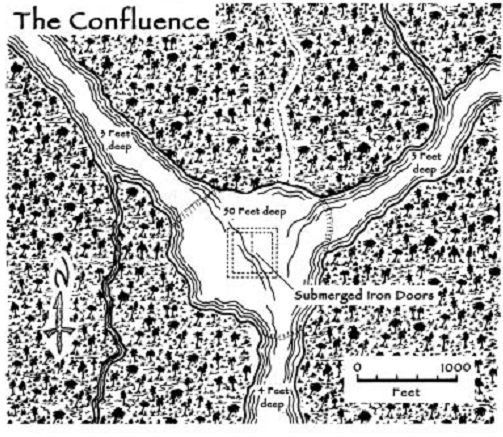
With no context beyond a section labeled "Mapped Dangers and Obstacles" telling us the streams are "only" 1-3 feet deep (telling me that the authors forgot that the PCs are probably all halflings). The paragraph also says that there are steaming pools (which do not appear on the map) which can inflict steam damage and produce mudmen.
Next we have a paragraph on following the trail (automatic success for those with Tracking, otherwise an Int-1 check). It still tells us nothing about how far this trail actually is.
It also tells us that PCs make an Int check to notice they're being watched and a second Int-5 check to actually spot 1d6 Bvanen at the edge of their vision (which means...20 feet away?) The Bvanen will follow the PCs to and back from the pyramid and even have a 30% chance to help the PCs if they're in trouble but may react with hostility if the PCs are aggressive.
The Inverted Pyramid
The trail will lead the PCs to the Confluence (the map that showed up a few pages ago). The pool in the center is unusually deep (50 feet) and the situation will be very different depending on whether the PCs arrive in daytime or nighttime (in which case it would be important to know how long it took to get here).
If the PCs arrive during the day the trail just leads to the edge of the pool, which is too murky to see into. If the PCs swim to the bottom they'll find a rusty iron door...250 feet by 500 feet. The door is far, far too heavy to be moved, but a knock spell will open it...a spell that no halfling character would have access to and probably couldn't cast at the bottom of a pond even if they did. If opened magically the doors will slide open and the bottom of the pond begins to rise, revealing an inverted floating pyramid.
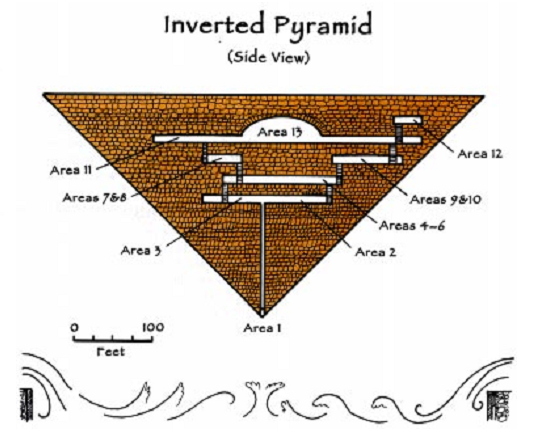
Hopefully whoever opened that door didn't cling to the pyramid as it rose into the air because they are now 600 feet above the ground with no way down. The "door" only leads to a shaft filled with water and nothing else, to a depth of 500 feet. The actual entrance is at the bottom of the pyramid...which is also floating 100 feet above the ground.
Of course if the PCs come to the place at night the pyramid is already floating there. It apparently does so every night, rising up on its own and floating above the swamp.
Let's just think for a moment how dumb this stronghold is. The whole "knock spell to lift up the pyramid" thing is really weird and inconvenient but its at least decent security...except the entire pyramid floats up all on its own every single night.
And again things get a little bit out of order:
First we're told that the Reggelid are watching the PCs from the swamp (apparently along with the bvanen...which means two groups spying on PCs a mere 20-30 feet away given the visibility here. The Reggelid wait to see how the PCs get in and follow them. The group consists of 5 standard reggelids who seem to be 3rd level wizards and their leader who appears to be a 7th level spellcaster. The stat-blocks here claim that reggelids are vulnerable to life-shaped objects, taking 1d6 damage when touched by them. This is not something that shows up in their full monster description at the end of the book, so clearly there's been some editing issues. Also, despite apparently living in the swamp and actively searching for the pyramid (which they know is a storehouse of magic) they've never notice the 500 foot tall pyramid that floats above the swamp every night.
Then we're told that the Chahn and Sahl have already arrived at the pyramid and many of them have been killed in the swamp already. There are six remaining 4th level fighters and its leader a 7th level fighter/thief as well as Sahl himself (6th level fighter/thief). Sahl has told them everything he knows and they don't know what to do next. Despite this they apparently did manage to get inside and are going to be encountered somewhere in the pyramid (GM's choice).
Next we're actually told how players are supposed to actually enter the pyramid. The entrance is at the bottom and the only way to get in is to move directly below the entrance which will cause it to suck up the person in a golden tractor beam from the pond. Of course, this shows the writers didn't really think very much about what this 50 foot deep pond is going to look like when the 500 foot tall, 500 foot wide pyramid leaves it.
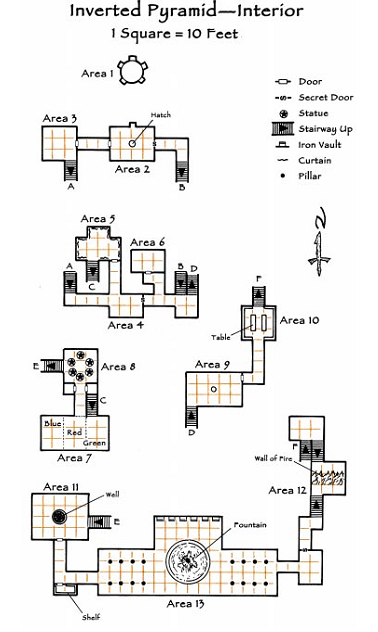
Despite the massive size of the pyramid the interior map is quite small.
Area 1:
This room is round and only 15 feet wide. There is a silver hatch set in the ceiling with no apparent means of getting to it. around the walls are 5 shallow alcoves holding blue gems (2" wide). Beneath one alcove is a blackened halfling corpse, one of Sahl's original companions. All her life-shaped equipment is fried as well.
Each gem is protected with a spell that inflicts 6d6 electrical damage on anyone that touches them. The only way to successfully activate the gems is to pass your hand over them without touching them. There is no indication of how to find this out, the gems don't glow, hum or otherwise give any signal when activate them correctly. They just shock you when you touch them.
Leaving the pyramid is done in the same way, you just have to desire to leave the pyramid.
Area 2:
Each area beyond the first is themed based on a school of magic. This one is themed on divination. Of course, this would be a more meaningful gimmick in an adventure where the assumption is that the characters not only aren't wizards (since halfling wizards don't exist back in 2e), but are also completely ignorant of the existence of wizardly magic at all.
The characters are deposited on a silver "landing platform" next to another blue gem (pass your hand over it and you're teleported back to Area 1). Above the gem is written runes in a unique language invented by Rajaat which (if read with a comprehend language or read magic spell) reads simply "divination". Why Rajaat would feel the need to label this chamber intended only for himself...who knows.
The room is a catalog of the magic items that Rajaat has gained over the years. On the eastern wall is a stone bookcase filled with ancient scrolls and tomes, all of which crumble to bits when touched. There's also a silver plaque with words in ancient rhulisti listing the items kept here (for some reason). In addition touching the writing will mentally transmit the information about the function of the item to the person touching it.
Just think...what reason would Rajaat have for creating this item. Keep in mind the amount of time and effort that goes into making your average magic item, especially back in second edition. Why would this super-smart archmage bother with this? Maybe if there were hundreds of entries that needed organizing...but nope there's 6. 6 items:
*A Sword of Sharpness
*Staff of Power
*Rod of Rulership
*Ring of Gray (a unique item intended to open a portal to the Gray and summon a spirit)
*Circlet of Life (Allows you to magically warp and manipulate living beings)
*Little Death (the plot item).
Each of these items are kept in their own separate vaults for some reason and all but little Death are already gone.
You may notice from the map that there's a secret door here. If you follow the stairs it basically leads to a separate section of each level (hidden by a secret door as well), the main door leads to Area 3.
Also recall the Regellid are apparently supposed to show up here and attack the PCs, presumably having figured out the gem puzzle without problem.
Area 3
This is the area accessible by the main door from Area 2 and is where Sahl's original group was driven back. It contains two mind-controlled and altered Thri-kreen. There's another magic label on the wall labeled "Enchantment/Charm". The corpses of Sahl's original team is here, with a selection of still-living (but near starved) life-shaped items.
The first Thri-kreen has a permanent Stoneskin enchantment, ignoring the first attack every round. The other has a magical Strength of 20 and crystal forearms.
By the way, if you recall the Chahn and Sahl have already infiltrated the pyramid you may be wondering when they'll make an appearance. Well the adventure suggests that they show up in Area 2, 4, 8 and 10. Keep in mind that if they show up in Area 2 that's two big fights in rapid succession (the chahn and then the regellid) which is probably going to be a complete TPK for a mid-level party that this adventure is designed for. If they don't show up in area 2 then...well how do they possibly show up in any of the other areas without dealing with these encounters already?
Area 4:
Accessible from Area 3 by stairs, this is an empty chamber where some of Rajaat's charmed halfling servants lived back when this place was being used. It contains only rotting furnishings and the door leading to Area 5 and a secret Door leading to area 6.
Area 5:
This door is locked with a conventional key lock (its unclear how a halfling thief would know how to pick such a lock). If the door is opened it reveals a gothed out room: rotting black tapestries a stained bone-white rug and black candles in silver candelabras. Unsurprisingly this is the Necromancy chamber. The halfling servants have been reanimated here as wights.
So...halflings basically have no magic items as far as I can tell. Nor do they engage in any kind of mining. Keep in mind that 2e wights are straight out immune to non-magical or non-silver weapons...so these guys are going to fuck up a team of halfling only PCs. The only ones who can hope to hold their own against them are elemental clerics who could hit them with magical damage or possibly turn them. But given the expected level of characters and the fact that most clerics are probably leaning heavily on healing and support spells and that wights drain levels with every hit...I think the party is likely screwed barring some exceptionally clever tricks or unusual supplies.
Area 6:
This area is only accessible via secret door. The secret door in area 2 leads to a set of stairs that will take you here, likewise a secret door in Area 4 will take you here as well.
For some reason all these secret doors are used to guard Rajaat's trash pit. Sure its a magic trash pit, containing the remnants of damaged, drained or useless magic items, but still not clear why this area demands higher security than the rest of the stronghold. Regular searching is useless but detect magic (assuming you've got a party cleric and they decided to memorize that) will find two remaining magic items: a necklace of missiles (still with two 3d6 and one 5d6 missile) and a damaged ring of free action which now works as a ring of clumsiness.
Area 7:
The alteration room. This room contains a trap to prevent further entry.
The room appears empty with colored floor tiles (evil wizards love floor tile puzzles!!) The left third is blue, the middle third is red, and the right third is green. Anyone touching the green zone will be affected by a Slow spell when they walk on the tiles. Anyone who enters the area of the red tiles (not simply walking on the tiles, merely being in the area targets you) are targeted by polymorphing beams. If you're already slowed your saves are at -4. Those who fail are transformed into small animals such as rats or lizards.
Touching the blue area will transform you back to your original form. However, its impossible to get to either exit without passing over the red zone again (barring a teleportation wild talent). Wasn't it nice of Rajaat to include that blue zone for no apparent reason.
Oh, and remember: fun fact, the life-shaped count as individual creatures meaning the average halfling adventurer is going to transform into a small swarm of little creatures...several of which are half-mindless and will probably just scurry in random directions.
Area 8
After getting past Area 7 there's a hallway leading to Area 8. The end of the hallway has a pair of closets containing statues (one ebony and one ivory) in the form of snarling watchdogs (again...are there dogs in Athas?) upon approaching the door to Area 8 the closet doors slide open, revealing the statues which function with the Repulsion spell, forcing everyone to make a save or be pushed back into Area 7 (right back into the red zone) and then back down the stairs into area 5 (so even if the PCs avoid transforming when they hit the red zone they'll have to go back through again).
The doors then close and the spell ends, but they'll reopen if anyone approaches again. The only way past is to somehow seal the doors, make your save against the repulsion effect or find the secret doors in Areas 2 or 4 which will bypass this area entirely.
The only contents of the room itself are statues of various humaniods mimicking spellcasting gestures. There is no magic or anything else.
Area 9
This is the "invocation" room and is only accessible via secret doors (from below via the rubbish room and above via area 12). No reason why this one is hidden away from the others is given.
There is a brass sphere hanging by chains from the ceiling which randomly targets anyone who enters with an evocation spell: If you're lucky it'll be a forcecage or web spell that lasts about 15 minutes (why?) or a couple of magic missiles (also why??). If you're unlucky it'll be a lightning bolt or cone of cold. Keep in mind that AoE spells will utterly demolish any life-shaped creations you're equipped with.
Area 10:
After area 9, this is the "minor vault" of lesser magic items. It's been mostly emptied but there are a few magic items here: potions of levitation, health and treasure finding, a metal long-sword +1. a rod of security with 5 remaining charges. and a ring of protection +1.
Disturbing anything sounds an alarm spell, but none of the guardians left behind are programmed to react to it.
Area 11
Back to the "main" section that isn't hidden behind secret doors. this is the highest part of the pyramid and this area is themed for summoning and conjuration. It has a large well in the center and the walls are carved with bas reliefs of different creatures, most warped or mutated. Upon entering the room a creature is summoned from the well. A Feylaar (30%) or two Bhrog (70%) (both unique athasian monsters).
better hope its the bhrog because the feylaar is baad news for a mid level party. Even more fun...every five rounds a new creature (roll again to see what) is summoned! the party is so fucked.
There's also a little room to the south which is where Rajaat teleported in and out of the pyramid (so...why have the elaborate entrance in the first place?)
Area 12
The illusion chamber. This room is the top of the 'secret door" section of the pyramid. The middle of the room is split by an illusionary wall of fire.
Or at least it claims its an illusion. The wall inflicts normal damage from both sides and there's no "save to disbelieve" mentioned or anything of the sort, the damage doesn't disappear or anything like that...its just a wall of fire that is supposedly an illusion.
There's a secret door to the south that leads to Area 13.
Area 13
The final chamber. Area 13 is the vaults where Rajaat stored his major magic items. Only little death is still around, but the place is still guarded.
The chamber is really big and contains a constantly flowing magical fountain, all carved with images of magical creatures. The vaults are along the north wall and all but the last is standing open. The last vault is locked and touching the door summons its guardian: Tethire, an athasian wraith.
Tethire is basically a hopeless fight: not only is it difficult to fight him at all since he can possess and animate your weapons and even when you fight him he can only be hurt by +2 or better weapons (which the party won't have) and has the ability to possess living beings too. He's far too tough to be turned by a cleric of the adventure's level and there's no way the party's minimal spellcasting abilities would include enough damaging spells to eat through Tethire's 51 HP.
He is at least somewhat merciful, if the characters surrender he'll allow them to leave.
If the PCs somehow manage to defeat Tethire they can unlock the vaults and get the little death: a wand which can (for 1 charge) shoot a beam that slays any single life-shaped being or (for 3 charges) shoot a 50 foot cone that does the same.
There's also the possibility of a plot hook for future adventures. the fountain contains an inscription that gives directions to another citadel (why? I don't know, apparently Rajaat is just absent-minded and needs to leave elaborate notes for himself). This would be a much bigger and more powerful place full of demons, super-monsters, etc.
Ending The Adventure
If PCs get little death and make it back they'll presumably turn it into Cohg-agon, who'll turn it over to the life-shapers (assuming they don't roll an encounter with a hydra on the way back and get their face's murdered).
If Sahl is rescued he'll try and stop the PCs from bringing little death back to Cohg-agon, claiming its his by right with all his friends dying (and his kidnapping) and may attempt to steal it back.
If the PCs decide to keep it they'll probably be hounded by life-shaper assassins.
And with that we have finished Windriders of the Jagged Cliffs! It was way worse than I remembered!
Well, I showed you guys that so we could kick it up a notch with the next book: Psionic Artifacts of Athas.